

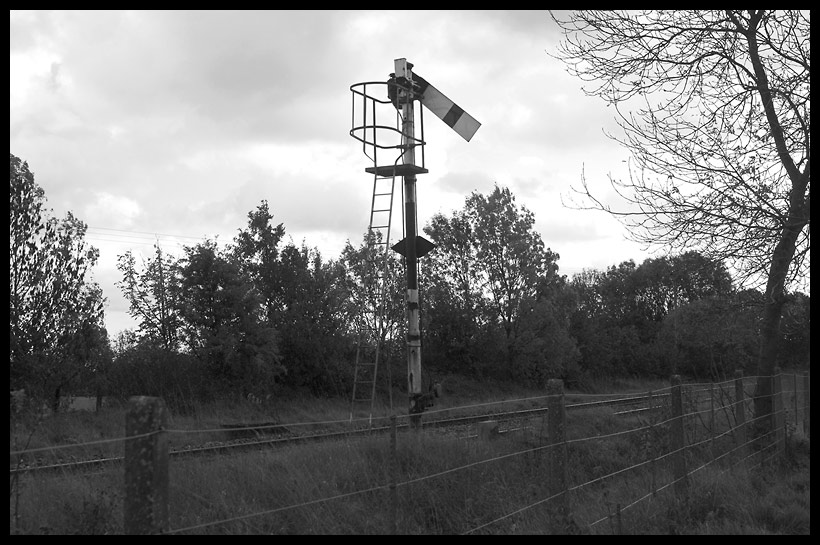
I have been fortunate in that I have obtained many photographs in the area, some of which already appear in various sections of this website, so feel that I have documented parts of the line reasonably well. This section does not pretend to give a comprehensive picture of every station and feature along the North Warwickshire Line but concentrates on the areas with which I have some affinity, mostly those with semaphore signals or other recognisable features. I am especially grateful to those railwaymen who allowed me to take pictures in and around the signalboxes, as mechanical signalling has always fascinated me. The three 'boxes that remained along this line until October 2010 were Shirley, Henley-in-Arden and Bearley Junction. The latter two were scheduled for demolition on 29 and 30 October respectively with Shirley to follow within a couple of weeks, despite a strong local campaign to save it. I have taken a few photographs inside each of the signalboxes over the years and some of these are included here. There are also a few of the exterior of Bearley Junction 'box which were possible only on an accompanied visit courtesy of Network Rail, to the officials of which I extend my appreciation.
Many of the pictures in this section concentrate on the railway infrastructure rather than just trains, and because of the nature of the traffic on a rural line, there are few locomotives pictured. This is probably the reaon that not many photographs have been taken along the line in recent years, other than of the summer Sundays' steam specials from Birmingham. I have always taken taken pictures of the local scene, especially where there have been semaphore signals, and in many ways prefer an afternoon doing this than spending time on a main line shooting yet another class 66 on an intermodal or the same class 60 on the same oil train. Those photographs will be available for years to come but those of the signalboxes and signals on the North Warwickshire line can never again be taken.
This collection of pictures is not intended to be a comprehensive survey of the North Warwickshire Line but more a few pictures of the various parts of it that I have found interesting over the years. In common with most lines there are many anonymous and bland locations which could be on any line in the country and I have, by and large, ignored these because I am more interested in showing the parts that have, or had, some character. I intend to add some more station shots as time allows because these are, now that it is no longer a through line to South Wales and the West country, the reasons for its continued existence.
This section should be viewed in conjunction with my Stratford-upon-Avon pages which show some historic scenes by other photographers along with some more of my own more modern views of the line.
|
|
The Shakespeare Express, this time from Worcester Shrub Hill, ran again on Sunday 17 August 2025. Because of the hot and dry conditions steam was banished with diesel being rostered and with good light looking to be guaranteed all day I went for a shot near Bearley Junction. First to pass was 2S06, the 10.27 from Worcester Shrub to Stratford-upon-Avon formed of 172007 + 172340. |
|
|
One of the only benefits of the recent dry and hot weather was, for diesel fans, that the Shakespeare Express from Worcester Shrub to Stratford-upon-Avon on 17 August was planned to run with 37240 topped and tailed with 47773 rather than steam because of the high risk of lineside fires. For reasons unknown only the class 37 was on the train when I saw it pass Kidderminster on the Railcams main line camera and this led to some delay as 37240 had to run-round the stock. Not to worry though, this made the usual reversal at Hatton unnecessary so the lost time was regained as 1Z71 was able to run direct via Hatton North and West Junctions. I picked a location at a foot crossing about 20 minutes walk from Wilmcote along the towpath of the Stratford canal and here is 37240 accelerating from a signal check on the other side of Bearley Junction. |
|
|
Given the clear blue sky and strong sunshine on Sunday 17 August 2025 it would have been rude not to have gone out again for 37240 on the Shakespeare Express, now 1Z73, returning to Stratford-upon-Avon from Birmingham Snow Hill. Having used a bit of an anonymous-looking spot for my first shot I went to Wilmcote station with its well-known footbridge for this one. Even at this time of the year shadows were becoming a bit intrusive at 15.25 but not enough to spoil things too much. |
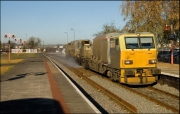 |
Given that Tuesday 16 November 2010 started with freezing temperatures and thick fog I didn't expect to see a lot of sun but the fog lifted well before lunchtime leaving a beautifully clear blue sky. That being so, I wandered down to Stratford-upon-Avon station just as the 13.27 DMU to Stourbridge Junction was leaving, in the hope of getting a couple of shots of the day's RHTT arriving. It ran much earlier than the previous day and sprayed its way into the platform just five minutes later at 13.32; a contrast to the day before when it didn't pass Edstone Aqueduct until 13.40. I was pleased to still see a bit of Autumnal colour in the Silver Birch tree adjacent to platform 1 as was half expecting the leaves to have blown off before now. |
|
|
A different sort of RHTT on Saturday 9 October 2021. I think this was the first run this year of the North Warwickshire Line's daylight rail spraying train 3S53 and as with the locomotive-hauled version on the Hatton line to Stratford-upon-Avon it seems a bit premature as the leaf-fall season hasn't started around here at least. I did think that some Autumnal colours might be in the background at Edstone Aqueduct near Bearley hence a trip out for a picture but with the exception of some hawthorn berries everything was still green. The train was running about 15 minutes early because of the cancellation of a Kidderminster to Stratford passenger service. It is usual for at least one diagram not to run each day at the moment through a shortage of train crews. |
_SonA_161110.jpg) |
It is hard to resist a few shots of any train standing in perfect light so I just had to take another view of DR98909 as it stood under Stratford-upon-Avon's footbridge on 16 November 2010. By now, the new LED signal at the other end of the platform had cleared and it was only a few seconds before the driver of the RHTT sounded its horn to warn a p-way gang that he was about to head their way and then back to the Birmingham area via Henley-in-Arden and Shirley. |
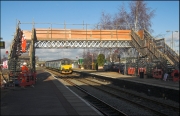 |
Following work to renew the station roof at Stratford-upon-Avon, attention has now switched to refurbishing the Great Western footbridge. So that this can be carried out without closing platforms 2 & 3, a temporary footbridge is in the process of being installed. On 18 January 2010 I wandered down for a look and arrived just in time to photograph the arrival of 150010 as it was about to pass under the new bridge which was having the final touches applied. |
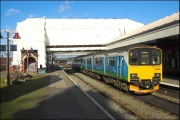 |
The original Great Western bridge, whilst still in use on 18 January 2010, was shrouded in plastic sheeting ready for, presumably, the metalwork to be shot-blasted before repainting. It isn't hard to see that the woodwork will need quite a bit of remedial work as much of it, particularly at ground level, has become quite rotten. Here, 150010 is leaving the station as the 13.27 to Stourbridge Junction. |
 |
London Midland, who operate the suburban railway services throughout the West Midlands, are soon to replace their ageing and increasingly decrepit class 150 DMUs with new class 172/3 units. One of these, 172332 visited Stratford-upon-Avon for, I think, the first time on 15 March 2011 on a mileage accumulation and test run. The train is here seen arriving into platform 2 at Stratford as the usual arrival platform for trains from Birmingham, No.1, was under possession by a gang carrying out refurbishment work on the canopy. It is only within the past few months that train have been able to run directly into platforms 2 and 3, the required work having been carried out when the resignalling of the whole line took place late in 2010. It's a pity that the sun wasn't out at the time because it would have been in the perfect place for this move. |
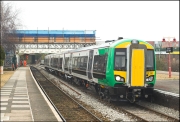 |
There was a turnround time of about ten minutes at Stratford-upon-Avon for 172332 before it retraced its tracks over the North Warwickshire Line to Tyseley, the main London Midland depot for the area. Here it is leaving the terminus with evidence of the work being carried out to the platform canopy and GWR footbridge, the latter having required the construction of a temporary footbridge so that passengers can access platforms 2 and 3. The corridor connection to be used when units are coupled will make revenue protection easier for the on-train staff and will generally increase the flexibility of the trains when compared to the existing class 150 DMUs. |
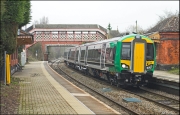 |
Once 172332, as shown in the two pictures above, had returned to Tyseley on 15 March 2011 it was sent on another trip to Stratford-upon-Avon. The new unit is here seen passing Wilmcote station with its distinctive GWR footbridge and buildings before dropping down the 1/75 of Wilmcote Bank before having to wait outside the terminus for the 13.27 from Stratford to Stourbridge Junction to clear the crossover. The return of 172332 happened in an unfortunate patch of bright sunshine; unfortunate because at this time of day it is in exactly the wrong place for photography so I didn't bother with another picture. |
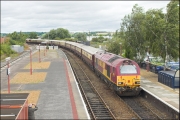 |
One of the few classes of diesel locomotive not previously to have visited Stratford-upon-Avon is class 67, although a signaller friend says that one may have reached Bearley Junction on an overnight engineering train from Bescot. Saturday 15 August 2009 saw the Northern Belle run from Leeds to Stratford with 67027 and 67002 performing the honours thus being the first class members to be photographed here. As a local, I felt it necessary to record the arrival at the station and here is 1Z83 coming into platform 1 with 67027 leading and 67002 just visible on the back of the train. |
_SonA_1508.jpg) |
While the passengers were alighting from the Northern Belle at Stratford-upon-Avon I made my way to the roadbridge over the line to get another view as the stock was shunted out of platform 1 and into No. 2. There was a bit of a delay as the rear of the train was beyond the platform end signal meaning that the points could not be switched and the shunt signal activated. The stock had to be pulled further south until the track circuits were clear before moving forward and out of the station as is seen in this photograph. This caused the following DMU from Stourbridge Junction to be delayed by some 10 minutes and which gave the unusual sight, witnessed from the road as I walked home, of two trains doing a bit of parallel running into platforms 1 and 2 respectively. The return to Leeds, 1Z84, was booked via the North Warwickshire Line but in the event was routed via the very much less interesting line through Claverdon and Hatton North Junction. The signal box at Henley in Arden was switched out but the preceding DMU would have been past Shirley, the end of the section from Bearley Junction, in plenty of time so this caused a bit of a disappointment for those of waiting for it. To me, this was the only route that had any interest as locomotive-hauled trains are not exactly unusual between Hatton and Tyseley... |
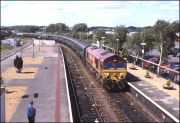 |
This pair of photographs from 10 June 2000 is similar to thise above in that they also show a charter train arriving and then shunting in platform 1 at Stratford-upon-Avon. This one depicts 66027 which was used in top and tail mode with 66096 on railtour duties; namely Hertfordford's "The Sword and Pen", running as 1Z41 Finsbury Park to Stratford-upon-Avon and 1Z42 return via the MOD facility at Fenny Compton. The train is here seen arriving at Stratford, pictured from the station footbridge. |
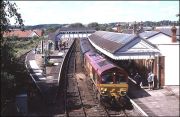 |
The same train as seen in the picture above is seen while shunting from platform 1 to platform 2 at Stratford-upon-Avon. Several young Network Rail "Suits" were in attendance for this exercise and their complete lack of experience and ineptitude was well demonstrated. As mentioned above, the train was run in TnT mode so one would have thought that a simple move such as this would have caused no problems. Wrong. First, 66027 was shutdown. Second, it was restarted and detached from the train. Third, and after a delay of some minutes during which the driver was consulted, the loco was re-attached and the shunting move carried out. There was, needless to say, considerable delay caused both to a local train from Birmingham and a Chiltern service from London. It is worth noting the colour change applied to the station infrastructure in the years between the two sets of pictures. |
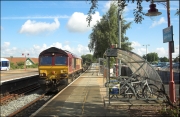 |
In connection with the latest engineeering work on the North Warwickshire Line, some Bescot drivers are having to learn the road to the terminus so that they will able to operate the required infrastructure trains. One of the route learners, 0Z30, ran on Wednesday 11 August and armed with a bit of foreknowledge and some sun I went to the station to get a record shot. Light engines can look out of place on the main line but with a bit of care can make for a reasonable photograph if some railway infrastructure can be included as with this shot of 66153 arriving at platform 1 a few minutes after the 09.27 to Stourbridge Junction had departed. The Chiltern Railways class 165 on the extreme left was about to leave as the 09.36 to London Marylebone. |
_SonA_110810.jpg) |
After arriving at Stratford-upon-Avon, 0Z30 ran under the road bridge and crossed over to the up line by means of the crossover situated on the stump of the former line to Cheltenham. It is here seen running through platform 2, generally used only by charters, before heading back to Bescot under a sky too good not to picture. The station has recently received new platform lights in the style of old gas lamps and these have also been installed along the approach road. The footbridge looks as if some work may soon be necessary judging by the state of some of the wood visible in this view. |
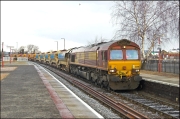 |
Most of the trains associated with the major engineering work on the North Warwickshire Line run overnight so as to allow the possessions to be lifted before the early morning passenger services begin to run. On Sundays, however, the passenger trains begin later and on 31 January 2010 this gave the opportunity to photograph 66081 with 6P01, a shortish rake of autoballasters, as it arrived at Stratford-upon-Avon to run-round before heading back to Bescot. Here it is running into platform 1 about 10 minutes early just as the Network Rail gang in the car park were kind enough to tell me that it would. It was booked to run back via Henley-in-Arden so I didn't hang around, having a feeling that it would be away well before the booked time, 09.50. |
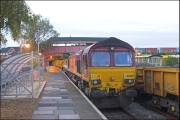 |
At about 07.30 on the morning of 28 October 2010 I was returning home after taking wy wife to work and when passing the station at Stratford-upon-Avon noticed that there were various engineering vehicles and at least one class 66 in the platforms. I went home to collect a camera and tripod and returned just as it was getting light. Here is 66069 standing in platform one with 6X23 alongside a long ballast train, ufortunately unphotographable, headed by another of the same class. This shot was taken with settings of 1/2 second at f6.3 with the camera set at ISO 100. |
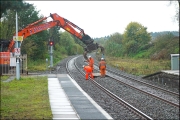 |
The train standing in the adjacent platform to that headed by 66069 at Stratford-upon-Avon was 6P42, due to depart for Bescot at 11.00. As I haven't had a lot of luck with the engineering trains thus far in the possession I went over to Henley-in-Arden in the hope of photographing 6P42 passing the station, but found that engineers were laying a temporary boarded crossing for use on the following day by the machinery employed to demolish the by now stripped signalbox which, on the previous day, was having the last panes of glass knocked out of the frames. Note that several signal levers are just visible in the grass alongside the track. It seemed unlikely that a train would be allowed over the line while this sort of activity was in progress so I headed back towards Stratford to see what was going on there. |
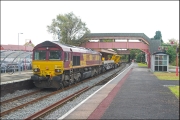 |
When I arrived at the station, 6P42 had disappeared but whether it had gone back to Bescot or just out of sight around the bend I have no idea. It did mean that another view of 66069 with 6X23 was possible so I took a couple of shots including this one with a wider lens, along with one of the Kirow crane standing further along platform 1. |
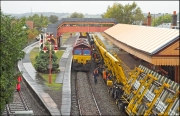 |
The weather on 26 October 2010 was quiet unpleasant with thick cloud and heavy rain being the order of the day. This unfortunately coincided with the appearance of 66124 at Stratford-upon-Avon with a 6X21 working of various rail carrying wagons. Here is half of the train in platform 1 with an unknown class 66 out of sight around the bend with the other portion in platform 2. A little later, the first part had gone leaving a much shorter formation standing in the platform normally used only by the summer Sunday steam excursions from Birmingham, as a work gang goes towards the car park for their lunch break. A new track section and up-to-date buffer replacing the wooden steam age version has been installed on the end of platform 3. |
_SonA_261010.jpg) |
Even though the weather was dreadful with accompanying low light levels I wandered down to the station at Stratford-upon-Avon to take a slightly closer view of 66124 and its train of rail carrying vehicles. It was pouring with rain so a brief spell under the platform canopy was a welcome respite from the soaking I had earlier had. The hyperlink gives the view from the station footbridge showing the formation of 6X21 along with another wagon parked in platform 3, usually used by the Chiltern Railways' trains to London Marylebone. New arrangements at Stratford will mean that trains will be able to access any of the three platforms directly from the main line rather than having to run into platform 1 and then shunt into one of the others. |
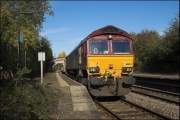 |
Sunday 24 October 2010 marked the first day of the major occupation of the North Warwickshire Line and during the morning I had a 'phone call from a friend saying that there were four engineering trains at various locations between Wootton Wawen and Wilmcote. I had a quick drive around and found 66124 on the rear of 6X21 in the platform at Wilcote station. The photographic opportunities were limited and this shot is about the best that could be achieved. The train had quite a mixed consist but there was quite a collection of these rail carrying wagons. |
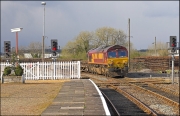 |
Whilst returning home with my wife from an afternoon stroll on Sunday 6 April 2008, I noticed a class 66 standing just outside Stratford-upon-Avon. Locomotives here are quite rare so I went home, picked up my camera and went back for a closer look. 66152 was standing on the rear of a train of redundant track panels. The crew had just arrived and were checking over the train prior to departure. Here is another view of 6P01 taken from a slightly different angle and as a snowstorm rapidly approached. The following saw the train, minus locomotive, standing in platform 2 of the station. I had hoped to see something coming from Bescot to pick up the wagons but nothing appeared in between the usual DMU traffic. |
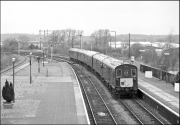 |
The preserved Hastings DEMU has for over 20 years made regular trips around the country visiting places that members of its class would never have seen when they were in normal service. On 8 March 1997 it ran from Hastings to Stratford-upon-Avon running via Kensington Olympia, Reading, Oxford and Hatton. The weather was, unfortunately, dreadful and I don't recall that I even attempted to take any colour transparencies. If I do find one then I'll try a scan at some point. Here is 1001 running into platform 1 at Stratford with just one other photographer present on the end of the platform. The semaphore signals were only months away from removal and it was good to record this scene with them still present. The DEMU had previously visited the terminus on "Midline Day" in April 1987 when it formed the regular (although infrequent) service to Leamington Spa. |
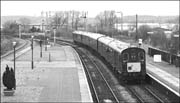 |
After arrival at Stratford-upon-Avon on 8 March 1997, the Hastings DEMU ran into platform where its water tanks were replenished. For such an unusual working I was surprised by the lack of enthusiast attention even on such a dull day; I think that most of those visible on the platform were passengers on the trip. From a local history point of view, the Safeway supermarket, now Morrison's, in the background was built on the site of a rail-connected World War II cold store which had been demolished within the previous few years. The older building is clearly seen in this view of a diesel parcels unit rescuing a failed DMMU on 16 May 1986. |
_080397.jpg) |
My final shot of 1001 at Stratford-upon-Avon was taken from platform 1 as it stood in platform awaiting departure time. I think that the tour participants were given a reasonable time to visit the town before they left for Birmingham via the North Warwickshire Line. The itinerary after Stratford was a visit to the newly reopened Birmingham Snow Hill where the train reversed and ran south via GWR main line to Leamington Spa and beyond. I did take a picture of it along that route but it falls outside the ambit of this section. |
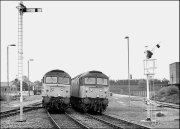 |
Sometime around 1990 the signalling and point locking arrangements were changed at Stratford-upon-Avon to allow departures from platform 1 to remove the need for trains to shunt after arrival in to either platform 2 or 3 before leaving. Unusually, a new semaphore signal was provided for platform 2 and the tall starter was reallocated to platform 1. On 4 May 1991 a charter from Henley-in-Arden to York was organised, with the stock coming to Stratford in order to run-round. 47805, on the left, was the train engine and 47281 was sent to shunt the stock from platform 1 to platform 2. The latter has just reversed the stock into platform, been uncoupled and is about to return light engine to Birmingham. The train locomotive then shunted onto the stock ready for departure for Henley and York. Ironically, a new locomotive-release crossover had just been installed to the south of the station to simplify things, but the authorities seemed unwilling to sanction its use at this time. |
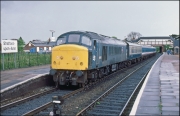 |
Stratford-upon-Avon has always seen occasional charters and railtours and on 2 May 1988 45052 arrived with The Avon Lady from London St Pancras having run to Birmingham and down the North Warwickshire Line via Henley-in-Arden. The poor weather meant that static shots were going to be the best bet so I took this shot as the train, 1Z37, was waiting for the ground signal to be pulled off so that it could pull out of the station, go beyond the crossover and then be propelled into platform 2 ready for departure. All this was necessary because no loaded passenger trains were at the time allowed to depart from platform 1 because of the facing points into the down goods loop. The situation in 2010 is very different, with trains able to arrive at and depart from any of the three platforms without shunting. |
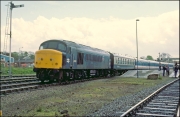 |
Once 45052 had moved into platform 2 on 2 May 1988, I asked the PIC if it would be OK to go off the end of the platform to take a shot of the train. He was quite happy about this and accompanied me while it took my photograph. The use of Network South East stock was, I think, a first for the terminus and it was a shame that the light didn't improve enough to really show up the colours. The full itinerary of the train can be found here. |
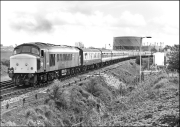 |
I can't now remember at what time The Avon Lady was booked to leave Stratford-upon-Avon but I did record the departure from the industrial estate just around the corner from the station. This should have a colour photograph but thinking that, at usual, it would be possible to get 37 exposures on a film with 36 frames didn't bother to change films. As a result all I obtained was a half frame shot of 45052. The train used a rare piece of track for a locomotive hauled formation in that it went back towards Birmingham via Bearley Junction, Claverdon, Hatton West Junction and Hatton North Junction, the curve between the latter two of which was used only by a couple of DMUs each day. |
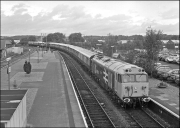 |
A 1998 arrival at Stratford-upon-Avon is here seen as preserved 50050 arrives at the terminus, by now signalled remotely from Bearley Junction, with the VSOE from London Victoria. Privately owned locomotives were used on this exclusive dining for a while before EWS (now DBS) took over responsiblity for providing the power. The timings for this train were convenient and fitted in with my lunch break from the office, the train arriving after the 12.27 local to Birmingham had cleared the platform giving plenty of time for the passengers to alight and for the train to shunted into platform 2. Here is 50050 running round the stock on the locomotive release headshunt on the other side of the Alcester Road bridge from the station. |
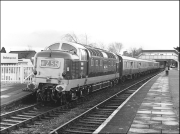 |
A more recent rare visitor to Stratford-upon-Avon is seen here. D9000, Royal Scots Grey came to the town on the early morning of 9 December 2000 with a railtour from Shirley, on the North Warwickshire Line, to the Lindum Fayre at Lincoln. When I was a young enthusiast in the 1960s, I would no more have dreamed of a seeing a Deltic here than Sir Nigel Gresley or Mallard, both of which appeared here in the 1980s. In fact, there are now very few classes of locomotive, steam or diesel, not to have visited the town. The train, reporting number 1Z55, is here seen at 08.15, just before departure to Lincoln via Hatton West to North Junctions and thence Birmingham, Water Orton, Hinckley, Leicester and Nottingham. I did also take a colour transparency of D9000 but the lighting was a little difficult with the sun rising and illuminating the other side of the train. After returning from Lincoln, the train departed from Stratford shortly before 10pm and I did stand outside my house, about a 5 minute walk from the station, to hear it roar away up Wilmcote Bank and back to Birmingham. |
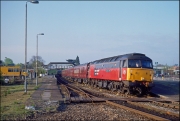 |
This photograph shows 47738, named Bristol Barton Hill, with the Royal Scotsman stock standing in platform 2 prepraring to leave with an early morning departure for Perth. I lived within sight of the line when this shot was taken on 29 April 1994 and had seen the train rolling in during the previous evening. A few enquiries at the station established the departure time which, being 07.30, needed a sunny morning to make the most of the picture. This was the first visit of the stock to Stratford-upon-Avon and it becamse quite a regular over the next 2 years, before the terminus was taken off the list of destinations. 645 |
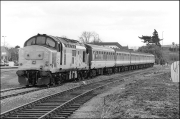 |
There have always been occasional excursions to Stratford for no other reason than to allow passengers to enjoy the historical aspects of the town or to simply enjoy a walk along the River Avon. This train, headed by 37418, came from Cardiff on 19 March 1994 and was organised by Regonal Railways. This day was notable in that a long-serving member of the station staff, Aubrey Wheeler, retired at the end of the afternoon shift and I was lucky enough to be invited into the staff room for a drink and to witness Aubrey's presentation by the Area Manager. I took advantage of the quiet spell outside to nip across the tracks and take this shot of the train standing on platform 3. Since then, the siding in the foreground has been lifted, this being done when the station area was resignalled. |
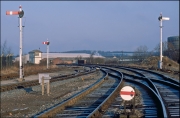 |
This and the following two pictures were taken on Sunday 11 January 1986 when I took advantage of the fact that there were no trains to Stratford-upon-Avon on winter Sundays. It shows the scene looking north from the station including the ground signal used by trains shunting from platform 1 into platform 3, the starter for platform 2 and the starter for what was locally called the "cold store siding"; the line adjacent to the platform 3 road. Stratford-upon-Avon East signalbox is also clearly visible just around the curve beyond the bridge taking the lines over the Stratford canal. On the right is the inner home signal and just beyond that the World War II air raid shelter made from a large diameter concrete pipe buried under a few feet of soil. The engine shed was adjacent to the goods loop which passed to the far side of the shelter so the shelter was handy for the men working there, but less so for the station staff. Incidentally, the top of the shelter was a useful photographic vantage point for anything leaving the station in the morning as witnessed by this 1984 picture of 45020 on a Henley-in-Arden to York charter sent here to run-round. |
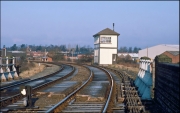 |
Standing on the canal bridge itself gave a good view of the signalbox and the surrounding environment. The signalbox was erected here in the 1930s but wasn't new having been previously in use at Acton. As ever, the GWR was mindful of expenditure and was an early proponent of recycling. I spent many happy hours in this box over the years in the company of the regular signallers who were always happy for some company and allowed me to flick through the weekly Special Traffic Notices and other papers that arrived each Friday in case anything of interest was running in the area. The view looking towards the station from the signalbox window was interesting and this shot of 37418 on a private charter shows the now changed background to some advantage. For a closer look at the 'box use this hyperlink. |
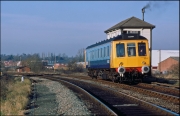 |
The West Midlands area railway operation was branded "Midline" in the mid-1980s and single unit DMMU 55033 was painted into their house colours. The "bubble car", originally a Western Region train, is here seen passing Stratford-upon-Avon East signalbox on 22 December 1986 forming a late arival from Leamington Spa. The signalman, an ex-locomotive fireman, was obviously in the process of firing his stove at the time. Those iron stoves really kicked out some heat and it's no surprise that the sliding window was open even on such a cold morning. The same unit stayed on the Stratford - Leamington diagram all day and here is a view later in the afternoon as 55033, numbered (T)083, passes the outer home signal. It will be seen from the frost on the sleepers that the temperature didn't rise much above 0 degrees Celsius all day, and I remember being grateful for the warmth and cups of tea I benefitted from in the signalbox between trains. |
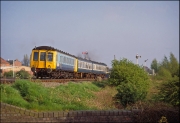 |
I always had a soft spot for the single unit "bubble cars" used for many years on the Stratford-upon-Avon to Leamington Spa trains. In the later years of its life, 50033 was repainted from the standard blue and grey into a livery based on the house colours of Midline, the marketing name for the Western MIdlands PTA. This picture shows the unit together with a class 114 two car set leaving Stratford with the 18.30 to Birmingham on 2 May 1994. The photograph was taken from the towing path of the local canal at a time when the vegetation had not encroached too much and the semaphore signalling was still in use. The train left from platform 1 which was controlled by the tall upper quadrant starter showing a clear aspect. Neither the single unit or the class 114 were to be seen here for much longer as their replacement, in the form of class 150 sprinters were coming into service. 645 |
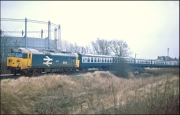 |
This was the first class 50 that I photographed at Stratford-upon-Avon. The "Bard 'n Brush" came here on the very dull and freezing cold 1 February 1986 behind 50011 which is here seen in the down goods loop after the locomotive had propelled the stock into the loop, been detached and run along the main line to a crossover on the other side of the signalbox, entered the loop, reattached and was in the process of pushing the train back into platform 1. Things are much easier today as there is a loco release facility on the other side of the Alcester Road bridge. |
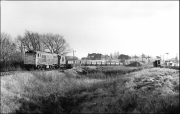 |
Standing in approximately the same spot on the goods loop as 50011 at Stratford-upon-Avon is 31257 while in charge of an engineering train in October 1988. It is just about to propel its wagons out of the loop in platform 1; the upper quadrant signal allowing this movement is just about visible at the bacl of the train. The Victorian hospital visible over the middle part of the train was largely demolished in the 1990s to make way for a bland modern hotel; the only good point about the whole process being that the original clock tower was retained. |
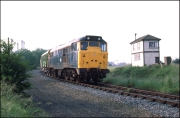 |
Just about everything in this photograph has gone. 31286 was standing on the down goods loop outside Stratford-upon-Avon station with the Chipmans weedkilling train on 16 June 1987. The signal box, signals and gas holders have long since disappeared, the loop itself has been lifted and the locomotive and stock have been scrapped. |
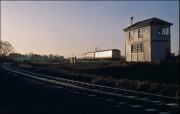 |
This is the scene from roughly the same spot as the picture above but looking towards the main line. The train is the 08.20 Stratford-upon-Avon to Birmingham Moor Street pictured on the frosty morning of 20 November 1986 with the rising sun giving the usual 3 carriage class DMMU an attractive golden glow. |
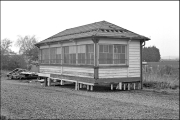 |
I mentioned above that the signalling at Stratford-upon-Avon was, by September 1998, controlled from Bearley Junction using electrically operated colour light signals. This is my final shot of Stratford-upon-Avon East Signalbox, or at least part of it, after removal from the base and apparently heading for preservation. I had hoped to obtain a mmomento from the signalbox, in the form of a redundant track diagram which had been removed some time before and shoved behind a cupboard but when the regular signalman went to retrieve it for me, someone had beaten him to it. |
 |
This is what a weedkilling train looked like in 1986. 47013 is pictured approaching Stratford-upon-Avon at 6.15am on the morning on 4 June. It was very unusual to see the goods loop signal in the "off" position but a quick word with the signalman and the promise of a copy of the photo sorted that out. The train is routed directly into the goods loop which now has long disappeared as have the semaphore signals and associated signalbox. |
_weed_sona_4686.jpg) |
Another shot of the weedkiller on 4 June 1986 shows 47013 crossing over to the up main line at Stratford-upon-Avon. The background and railway infrastructure has changed since the date of the photograph. The semaphore signals have gone, the cold store dating from the 2nd World War, visible behind the locomotive, has been replaced with the inevitable supermarket and the second world war air raid shelter upon which I was standing has also been consigned to history. |
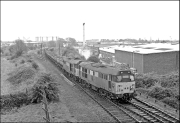 |
There were four Sundays of engineering work between Stratford-upon-Avon and Wilmcote in early 1993. Most of the work took place on the up line and trains ran to Stratford to allow the locomotives to run round their trains and then head north to the worksite. Pairs of class 31s were used each week and I tried to obtain some photographs in different locations week by week. The train on 25 March 1993 ran to just short of the platforms where the locomotives were detached, ran forward and then backed onto the train via the crossover just to the north side of the signalbox. The signalman wasn't happy about this as he didn't feel that these very rarely used points were up to the job and suggested that I should keep well out of the way in case something went wrong. I felt that this elevated position would be safe enough and in the event 31546 and its unidentified companion safely negotiated the crossover with the spoil train and went off to Bescot. The recently severed connectiion to the down goods loop is clearly visible to the left of the train and it wasn't long before the track was lifted. |
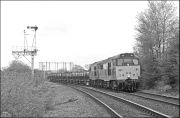 |
I mentioned in the caption to the photograph above this one that the down goods loop at Stratford-upon-Avon was severed in early 1993. One of the results of this was the removal of another arm from the signal gantry which had originally carried three arms, the smallest of which gave access to the goods yard and which was removed before I started taking photographs. Another engineering train, this time in 18 April 1993 with 31533 + 31186 in charge, is here seen leaving Stratford after having run across the crossover just to this side of the signalbox. In the period between the date of the previous picture and this one, the points mechanism had been greased and serviced to help ensure that nothing untoward would happen. |
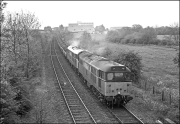 |
This photograph was taken from the first overbridge on the line out of Stratford-upon-Avon and shows 31186 + 31533 trying to gain speed with their spoil train before hitting the 1/75 of Wilmcote Bank. My notes aren't up to much at the best of times and I don't seem to have written down the date of this picture but it was probably about the 25 April 1993. A new bridge was built here to accompany a new road and the high parapet, linked with unchecked growth of lineside vegetation has just about done away with this shot. |
|
|
A weekend of engineering work took place at Bishopton, just outside Stratford-upon-Avon, over the weekend of 13 & 14 February 2003 when part of the down line was relaid. Only one train was involved although some road-rail vehicles did some of the work. One of these is shown here dismounting the newly laid track in front of 37695 which allow 7P04 to creep forward and began its ballast drop. This location is now the site of Stratford-upon-Avon Parkway station. |
|
|
As soon as the road-rail vehicle had cleared the tracks at Bishopton on 14 March 2003, 37695 from Bescot with 7P04 moved onto the newly laid track and began to drop ballast. The driver of the train got in touch with me via a mutual friend asking for a photograph and in passing told me that 37695 could barely drag itself along. It was apparently in very poor condition with air leaks making it virtually impossible to keep the brakes off. It certainly seemed to make heavy weather of Wilmcote Bank a couple of hours when I took this rather distant broadside view as it left the possession and headed back to Bescot. |
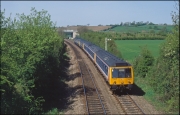 |
The Bank Holiday Monday on 2 May 1994 saw some Birmingham to Stratford-upon-Avon trains formed of DMMUs rather than the then by usual class 150 sprinters. Here is a mixed set led by Network South East liveried L743 passing the long-gone Stratford down distant signal between the two bridges at Bishopton. This signal was rarely raised to the clear position; in steam days virutally everything stopped at Stratford either for water or to pick up passengers and even in the days when the line saw diesel hauled freight it would have been necessary for the Evesham Road crossing gates to have been closed and the road set to allow this to happen. In practice, this meant that the road would have been blocked for far too long, so trains were generally checked as they approached the station. One of the signalman told me that he would never have pulled the distant off for anything other than the Royal Train; with no power assistance it would have been a real gut-wrenching effort! By this time, of course, the signal was no more than the statutory fixed distant. The view looking towards Straford was less photogenic as a rusty fronted T351 leads the way back to Birmingham. |
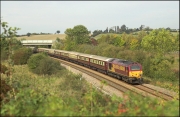 |
The Northern Belle made its third visit of 2009 to Stratford-upon-Avon on 9 October. The train started from Leeds and as well as Stratford, passengers were able to alight at Birmingham International for the Horse of the Year Show. The original plan was it to run from Birmingham International to Coventry and Leamington Spa, before reversing and heading for Stratford via Hatton station. In the event, the plan changed and the reversal took place at International with the train running via New Street and Dorridge to Hatton North and thence on to Stratford via Bearley. Here is 67002 leading the smart stock through Bishopton and passing the site of the Park and Ride station due to be constructed in the near future. This site was chosen because it is immediately adjacent to the existing and under-utilised Park and Ride for car travellers. With the reversals planned for the journey it was obviously necessary for the train to be topped-and-tailed and 67001 is just visible under the bypass bridge in the background. |
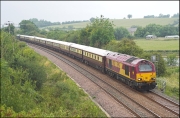 |
The Northern Belle luxury train was scheduled to travel from Leeds to Stratford-upon-Avon on Friday 13 August 2010, running via Dorridge, Hatton North & West Junctions, and Bearley Junction with a booked arrival time of 12.31. When I photographed 1Z73, led by 67021 with 67005 on the tail, dropping down Wilmcote Bank it was running a few minutes early and would have had to have waited for a few minutes outside the station until the 12.27 DMU to Stourbridge Junctiion had left platform 1 and cleared the associated crossovers onto the up main line. The weather was filthy, as I have come to expect for charters to Stratford, with a blustery wind driving rain straight into my camera's lens. |
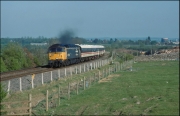 |
In 1990 InterCity had a very smart set of stock exclusively for its own use on charter trains which visited Stratford-upon-Avon on 28 April 1990 with a special from London Paddington. The arrival was timed for late morning when I was unable to leave work but the return was booked out at 17.30 which gave me plenty of time to head for a location mid-way up Wilmcote Bank for a photograph. A lot has changed since then I imagine that 47816 has beens scrapped and the gasholder and chimney visible in the right-hand background have certainly gone, along with the landfill site; now the local authority's recycling and rubbish disposal centre. The undergrowth has also flourished making an exact repeat of theis view impossible, although a much more head on and less satisfactory picture from a point further down the bank is still possible. The curvature of the track just outside Stratford station is demonstrated here; the line runs between the gasholder and aluminium chimney. |
 |
Stratford-upon-Avon has been a popular destination for the VSOE since it started running as a tourist train in the early 1980s. It regularly ran with class 33 power and here is 33028 passing Wilmcote station on 22 May 1987. It is interesting to see how unkempt the station then was compared to the model of tidiness it presents today. The weather was dreadful but the chance of a Crompton to this normally DMU-only outpost was too good to miss, especially the ECS was unusually booked via the North Warwickshire line to Tyseley for servicing. |
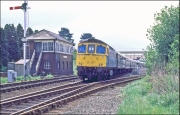 |
As mentioned above, 22 May 1987 saw the VSOE travel over the North Warwick line from Bearley Junction to Tyseley for servicing. Locomotives of any description are rare on this line but a 33 hauling the VSOE stock was huge! It was the first Crompton I was aware of to use this line since the route was truncated at Stratford in the 1970s. The train hauled by 33028 is seen here in the early afternoon passing the open signalbox at Henley-in Arden - these days it is switched out after the morning peak-hour shift and is due for closure and possible demolition towards the end of October 2010. |
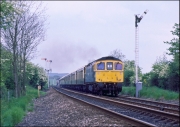 |
Once the VSOE stock had been serviced at Tyseley on 22 May 1987 the train returned to Stratford-upon-Avon ready to pick up its passengers for the return to London Victoria. I walked along the towing path of the nearby canal to a foot crossing so as obtain a shot of 33028 and the smart coaches passing the semaphore signals on the down side of Bearley Junction. The bracket signal protecting the junction still had lower quadrant signals at this time but were changed for those operating in the upper quadrant some time afterwards. They will all be removed in favour of colour lights by the end of October 2010 when control of the line is passed to the panel at Landor Street Junction, Birmingham. |
_220587.jpg) |
This view of Bearley Junction has not been possible for some time because of a proliferation of modern lineside equipment put there largely when the signalbox at Stratford-upon-Avon was demolshed and control of the terminus passed to a small panel in the box here. By the end of October 2010 this scene will have changed again with the removal of the GWR box (albeit with a Midland Railway frame) when the resignalling of the lines to Stratford is complete. The VSOE hauled by 33028 is here seen on 22 May 1987 passing the junction and joining the single track to Hatton West Junction from where it will head up to London Victoria. |
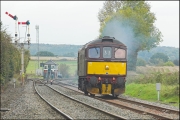 |
On Wednesday 15 October 2008 the steam locomotive 30777 Sir Lamiel was due to visit Stratford-upon-Avon from London Victoria. To assist with shunting the stock and to bank the returning train out of the station, WCRC 33025 was sent light engine down the North Warwickshire Line, being due to arrive about 30 minutes before the main train. It won't be too long before the mechanical signalling and associated signal boxes along this route are removed so I thought a walk to one of the several footpaths crossing the line between Bearley Junction and Wilmcote might be a good idea so that I could update my photographic collection, not having been along there for years. 33025 appeared on time, following a class 150 DMU from Stourbridge Junction and is here seen seen accelerating away from a long-standing temporary speed restriction across the junction at Bearley. The loose-looking support wire for the bracket signal, appearing above the locomotive, doesn't seem to be performing any useful function! |
|
|
Paths for test or crew training runs between Tyseley and Stratford-upon-Avon featuring West Midlands Trains' 196101 have been showing up for about two months. There has been a single outing to Hereford, seen here at Droitwich and it went to Crewe during the night of 10 & 11 August 2020. The first working to Stratford on 11 August 2020 for the unit was cancelled so I assumed that the rest of the diagram wouldn't be used and when I checked for the second run at 10.40, a few minutes after the scheduled departure time from Tyseley LMD there was no sign. However at 11.15 I had another look at a mapping app saw that 5Z22 was at Earlswood some 8 minutes late and reckoned that with light traffic I was in with a shout of getting to Edstone Aqueduct, near Bearley Junction in time. Just as I set up on the canal towpath 2 boats were heading towards me and it was fortunate that the second of these cleared with a few seconds to spare before 196101 appeared. The undergrowth between the up and down lines has flourished this year but an 85mm f1.8 lens and a bit of cropping in the raw convertor tidied the scene a bit. |
|
|
There was a shorter return journey between Tyseley and Whitlocks End planned for 196101 on 11 August 2020 but this was cancelled. The next train to Stratford, 5Z24, did set out from Tyseley and given the 30ºC temperature I had no intention of standing in a sunny spot so went to Wilmcote to 1) take advantage of the shade from a tall hedge alongside the platform and 2) take my image with a recognisable and classic background. Here is 5Z24 drawing to halt in the station presumably to allow trainee drivers get a feel for the train's brakes and thus pull up in the correct spot. It was only at this point that I realised that the corridor connection was black whereas on the unit's first run it was yellow. I imagine that there must be some piece of yellow board available to insert in the front as required.The next run due to arrive at Stratford-upon-Avon at 16.30 was cancelled and I can't pretend to be too disappointed given that the temperature and humidity had kept on rising throughout the afternoon. |
|
|
West Midlands Railways' brand new 196104 made its first test runs on Wednesday September 2020 with 3 journeys between Tyseley LMD and Stratford-upon-Avon. The second trip, 5Z22, was the only one that I was able to photograph and just about the only location on the North Warwickshire Line where the sun is useable is from the towpath of the Stratford canal at Edstone aqueduct so that's where I went hoping that no narrow boats would get in the way. Luckily, 5Z22 was running early and arrived nicely between 2 boats heading for the Wilmcote flight of locks on the way to Stratford. |
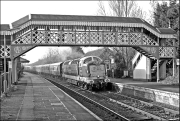 |
This pictures records the second time that a Deltic locomotive, D9000, ran to Stratford-upon-Avon. It happened on 7 April 2001 when it took a charter from the Warwickshire terminus to York and the outward trip is here seen passing under the GWR bridge at Wilmcote just as 1Z39 tops the 1/75 of Wilmcote Bank. The train was audible for several minutes, probably from the point that the engines were gunned as the locomotive reached the short downhill straight just around the curve from Stratford station. I have a video recording somewhere of the event and it is good to hear the drone getting closer and closer, with a field weakening, almoist like a gear change, taking place right in the platform. I should like this to have been a clour picture but the sun died only a couple of seconds before the shutter was pressed and with a manually operated Olympus OM1 there was no chance to alter the settings to save the exposure. I had earlier struggled to find a location at which to photograph the ECS movement, my favoured spot being out-of-bounds due to the foot and mouth crisis then ongoing. In the end I had to settle for a shot as the train came through Wootton Wawen station; not very inspiring with the sun far too low but certainly unique. |
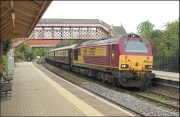 |
Looking the other way the picture above on 5 September 2009 here is a shot of the second visit in recent weeks of the Northern Belle to Stratford-upon-Avon. Wilmcote is on the way home from Hatton where I had been photographing earlier in the morning so it seemed silly not to drop in at the attractive station for a shot of 67027 passing through with 1Z67 from York. The light had entirely collapsed by the time the train was due but I felt that a picture was worthwhile as this is only the second daytime working of class 67 along the line. The train is here seen passing under the GWR footbridge, which although in reasonable condition is painted in a strange shade of browny-pink, quite unlike anything the GWR or any subsequent railway company has used. |
 |
Friday 6 November 2009 was a dull and drizzly day in Stratford-upon-Avon so I took the opportunity to obtain another couple of shots of 3S87, the RHTT that runs down and up the North Warwickshire Line with a reversal at Stratford. I do like to take pictures of these short trains in station settings so that there is some definable character to the shot, especially when the light is on the dire side of dreadful. Here is DR98908 leading the formation through Wilmcote, a pretty well preserved example of a Great Western country station, unusually with buildings still extant on both sides of the lines. That on the down side, adjacent to the train, has been closed for as long as I can remember but I can recall the booking office on the up side being in use. I believe that a cardboard model of the down side building used to be available and examples are probably in use on model railways somewhere in the country. |
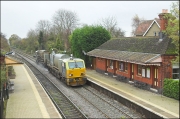 |
There wasn't too long to wait before 3S87 reappeared, climbing the last few yards of the 1 in 75 of Wilmcote Bank before passing the eponymous station, but even in that short time the light deteriorated quite dramatically.. I took this shot early enough to show the privately owned and well maintained buildings on the up side of the station, along with part of the substantial house once occupied by the Stationmaster here. The GWR knew how to look after their staff in the days when the holder of such a position was a prominent member of the local community. I know that it's down to personal choice but I do feel that those who photograph only locomotives in the countryside miss out on some great historic locations and infrastructure. In how many places does one see a bicycle shed built in such as style as this, with accurately shaped woodwork? OK, the colour, a pinkish brown, is not authentic GWR but it does match that of the other stations along the line. New London Midland Railway signs are gradually appearing in the area and I imagine that it won't be too long before Wilmcote gets the treatment. |
|
|
The monthly 1Q48 test train from Derby RTC to Tyseley via Stratford-upon-Avon and the North Warwickshire Line was retimed quite significantly on Tuesday 7 August 2018 and made its first of two trips to the terminus at lunchtime with an arrival time of 12.47. The sun's angle was most favourable around the Stratford Parkway area and I had a short but very hot 15 minute walk there from home. The train was running a bit early and passed the station 8 minutes ahead of schedule with 67023 leading 4 coaches and 67027. There is a bit too much ironmongery poking above the locomotive's roof but that is typical of both modern and recently refurbished stations. |
|
|
After visiting Stratford-upon-Avon for the first time on 7 August 2018 1Q48 ran to Fenny Compton before returning to Stratford via Hatton, Claverdon and Wilmcote. The station at the last of these retains some GWR artefacts and with a passing time of just after 15.00 this was just the spot to take advantage of the light and to give a good interesting background. A passenger train was due a few minutes after 1Q48 and I took this image at an appropriate spot to show those waiting to join their class 172 DMU for the short journey to Stratford. A shot of the northbound train isn't worth the effort in this past of the world so I left after 67023 + 67027 had passed. I must admit to not being too disappointed when 67s are diagrammed for the this working; on a sunny day with 37s in charge there would have been far too many bodies around in the best locations! |
 |
Tuesday 23 October 2007 was a bright and sunny and although I wanted to get out and take some pictures, I couldn't be bothered to travel far. That being the case and with my wife having taken a day off work, we walked along the towing path of the Stratford-upon-Avon to Wilmcote where there is a convenient occupation bridge. The first train to come along was 165001 forming the 10.54 London Marylebone to Stratford. Chiltern Trains' service don't appear to call at Wilmcote station these days, maybe because they run quite close in front of the Central Trains units from Birmingham which means that a quick shunt is required at the terminus for the first arrival and the time gained by not stopping at the station is useful here. |
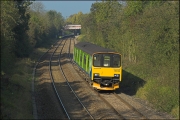 |
Next along was 150106, the 11.54 from Stourbridge Junction to Stratford-upon-Avon. I think it is important to record these everyday workings as in 20 or 30 years it will be these that are of more interest than the higher profile trains, which get photographed to death by every man and his dog. Just before the train left Wilmcote station, visible in the background, this Kestrel flew by keeping a beady eye on proceedings. |
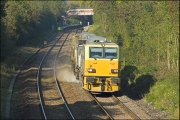 |
The 09.05 Rail Head Treatment Train from Kings Norton to Stratford-upon-Avon via the North Warwickshire Line, 3S87, was the final train I photographed at Wilmcote on 23 October 2007. As with all diesel units, the majority of photographers ignore these highly complex machines in favour of yet another shot of top-and-tailed locomotives doing the same function. I get far more satisfaction in picturing an MPV on my local patch than having to travel miles in Autumn, with its uncertain weather, just to stand in a gallery of other enthusiasts getting virtually identical shots. This is the last week that this shot, on a sunny day at least, will be possible. The shadows were rapidly encroaching and I had to use a powerful lens to get the train in a clear patch. Once the clocks have gone back, that will be it for this bridge until late spring next year. |
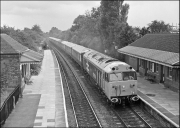 |
The VSOE visited Stratford-upon-Avon on 9 September 1998, arriving at lunchtime and departing sometime, if I remember correctly, around 5pm. It is here seen passing Wilmcote station the first out of the terminus, behind 50050 having just made a noisy climb of the 1/75 of Wilmcote bank. The light had been very poor all day and I didn't even bother to take my cameras loaded with colour transparency film out of the house. This picture, taken on 120 size TRI-X 400asa, was shot at 1/250 at f2.8 so it is probably a good job that the train was yet to reach much of a speed... |
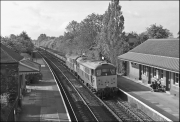 |
A different sort of English Electric power, not to mention a very different trailing load, is here seen on Sunday 15 May 1993 as 31105 + 31106 haul their spoil train through Wilmcote station. This date was the last of four Sundays of engineering trains on the line and was the only one where any sun appeared. Unfortunately, the sun appeared only at the last moment and I had taken with me only my Mamiya 645 loaded with black & white film. A shame, as I should have quite liked a colour transparency of this scene. |
 |
The remaining pockets of semaphore signalling in Warwickshire are scheduled for replacement in the Autumn of 2010 when control of the North Warwickshire Line is transferred to Landor Street Junction Panel. The nearest signals to my home are those at Bearley Junction and as Monday 8 March 2010 was clear and sunny I made up my mind to go and take a few shots from a couple of the foot crossings between there and Wilmcote. For reasons involving a sheep, a muddy, icy and slippery canal bank and the RSPCA I ended up at a crossing further north than I had intended for my first shots with the result that the sun wasn't quite as far round as I should have liked. Still, the signals were the real target with 165002 heading to Stratford-upon-Avon from London Marylebone being almost incidental and really just providing an additional prop. The signals here did, of course, operate in the lower quadrant, being firmly in GWR territory, but were converted a good twenty years ago to the then standard for semaphores. The splitting home signal was changed after the outer starter which had already gone over to upper quadrant operation by the time that I started taking an interest. |
 |
A land cruise, operated by Green Express, ran from Huddersfield to Stratford-upon-Avon and Oxford on Saturday 11 April 2009. I can just about raise enough enthusiasm for a railtour to my home town so took a walk along the towpath of the Stratford-upon-Avon canal to a boarded crossing just on the south side of Bearley Junction to get a photograph of 57601 topping the train with 47854 on the rear. The semaphores in this location are due for replacement in the near future when the North Warwickshire Line is resignalled so I was more than happy to get a locomotive hauled train here. The tour, 1Z73, was spot on time as it pulled away from Bearley Junction after waiting a few minutes for the preceding class 150 on a Stourbridge to Stratford service to clear the section. |
 |
The Railhead Treatment Trains (RHTTs) commenced operations during the week of 13 October 2008. In my part of the world, these are all MPV operated which I quite like as one doesn't get to see these vehicles very often. Here is DR98961 moving away from Bearley Junction on 15 October 2008 as it heads from the North Warwickshire Line towards Stratford-upon-Avon. The train was slightly delayed because of a "Cathedrals Express" with 30777 Sir Lamiel having run early and been allowed to precede it to the terminus. The weather was quite poor but this did allow the headlight of the MPV to give a nice reflection on the nearside rail. |
 |
Great Western distant signals operating in the lower quadrant are very thin on the ground. I can think only a two or three around Worcestershire, some in Cornwall and this one operated by Bearley Junction signalbox on the up line between Stratford-upon-Avon and Birmingham. I wasn't sure if it was being pulled off at the moment because of a speed restriction at the junction so was pleased to see that it was in use today. The Sprinter, 150019, is slowing for the stop at Wilmcote station on 8 March 2010 as it passes the signal on its way to Stratford. As I was keen to get a photograph of a train passing it in the "off" position, I waited until 150019 returned from Stratford as the 14.27 to Stourbridge junction. |
 |
A charter to Stratford-upon-Avon means, for me, that the weather will be dull and probably wet and quite possibly foggy. The West Coast Railway Company were in charge of a special to the terminus on Saturday 27 February and it looked as if the usual cloudy conditions had been ordered in advance. That notwithstanding, I went to a foot crossing near Wilmcote station as I wanted a photograph which included Bearley Junction's up distant, a rare example of an operational lower quadrant semaphore. This is the only one of its type on the line, Henley in Arden's up distant operating in the upper quadrant and all the others being colour lights. This signal, the post of which used also to carry a home arm in the days when Wilmcote had its own signalbox, is pulled off (with power assistance) for trains going along the North Warwickshire Line as this is the primary route at Bearley Junction. I'm not sure if it is currently used as there is a severe speed restriction at the junction and the signal may be left at caution as a reminder to the driver. Anyway, here is 47804 leading 1Z47 from Carnforth, with 47786 dead on the rear of the train, in marginally better than expected light, towards Wilmcote station somewhere in the region of 7 or 8 minutes early. It would had to have waited outside Stratford for 150125 to leave platform 1 at 12.27 with the hourly train to Stourbridge Junction. |
|
|
Class 172/0 172006 was again out for crew training runs on 12/13 March 2019. The weather on the earlier day was foul but by Wednesday 13th was much better with sunny spells. I wanted a shot of the former GOBLIN unit passing Wilmcote station with its GWR bridge albeit in poor condition and with the dreadful muddy pink colour scheme inflicted on much of the Midlands' infrastructure. Stations across the West Midlands Railway area are gradually being refurbished to some extent and the platform signs at Wilmcote have been replaced. Back to 172006, here it is running as 5T74, the 11.45 from Tyseley LMD, passing under the bridge running 4 minutes late having been delayed by the preceding Stourbridge Junction to Stratford-upon-Avon service. |
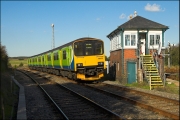 |
I was given the opportunity to visit Bearley Junction signalbox before it closed in October 2010. This picture, taken with a Network Rail escort, shows 150011 passing the 'box, the nameplate from which had already been removed, with a train to Stratford-upon-Avon from Stourbridge Junction. The upper quadrant signal visible of the right of the photograph is that controlling down trains heading for Stratford from the branch running from Hatton West Junction. Here is another view of the signalbox taken just before the train arrived. |
_Bearley.jpg) |
During my visit to Bearley Junction signalbox I was asked to take some photographs recording the interior. This is the frame at the down (Stratford-upon-Avon) end showing the mix of traditional and modern equipment. The mechanical frame is from the Midland Railway replacing the original GWR version but the block instruments are the originals and are connected to Henley-in-Arden 'box unless it happens to be switched out, at which time the block extended to Shirley in the West Midlands. This long section generally applied only on Sundays and odd occasions when a relief signaller was not available to help out the regulars. The green-faced panel in the centre of the picture controlled the points and signals at Stratford and came into existence when the 'box there was abolished. Here is a closer view of the panel showing a bit more detail. |
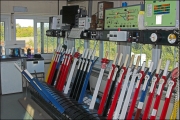 |
This is the view towards the Hatton and Henley-in-Arden end of Bearley Junction signalbox showing the array of disused levers painted white, along with those with shortened levers reminding the signaller that the signals they operate have power assistance and don't need any effort to pull. Also in shot are the electric cooker and refrigerator used by the signallers; these being relatively modern additions as it was less than 20 years ago that the 'box had a power supply only for the train describer, lighting being by gas lamps and with a water supply brought from Stratford on the second Leamington Spa train of the day. Bags of coal for the iron stove were delivered at the same time during the winter months and manually humped up the steps. |
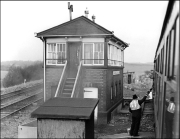 |
As I mentioned above, essential supplies of water and coal were delivered from Stratford-upon-Avon to the 'box by a Leamington Spa bound train. On the misty and cold morning of 24 January 1991 I travelled on the 08.12 from Stratford with the express purpose of obtaining a photograph of the process in action and here is a water container being handed to John Overfield, the signalman, by the guard of the class 114 DMU. It is scarcely credible that what was esentially a Victorian practice was still going on in the final decade of the 20th century. The nameplate of the box calls this 'box "Bearley West Junction" as, at one time, there were three signalboxes operational here. North Signalbox was situated close to Edstone Aqueduct and controlled both the Alcester branch and a single track curve to Bearley East Junction which was to be found a short distance along the Hatton Branch. This was used for diverted traffic on occasions that the Leamington Spa to Birmingham line was under possession and, on at least two occasions, was used to stable the Royal Train overnight. The late Tom Williams took several pictures showing traffic on the curve and these can be found in various publications. This 2010 picture was taken from a broadly equivalent spot and shows the numerous changes both to the 'box and the nearby environment. |
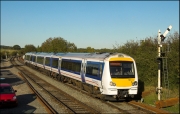 |
One the photographs I was keen to obtain while at Bearley Junction was this showing a London Marylebone to Stratford-upon-Avon service passing the 'box's starter signal as it leaves the single track from Hatton West Junction and joins the North Warwickshire Line for the run down to its destination. Class 168/2 168214 has had to slow to 20mph for the junction and will maintain this speed until it has passed the temporary speed restriction (which had been in force for years!) that terminated just before the advance starter a few hundred yards to the south. I know that this is a terrible photograph but the lighting conditions at the time of day for which my visit was arranged, with the sun coming from the back right-had side, were never going to produce a good picture looking south. At least it shows the old track layout and signals, along with the new junction signal with the feather, or route indicator, marking the route for trains going towards Hatton. Notable in the foreground is the now abolished diamond crossover with its movable elements, the intention of which was to reduce hammer blow on the track by train crossing over at speed from the Henley route. |
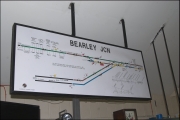 |
My final picture from the interior of the now demolished Bearley West Junction signalbox shows the track diagram and illuminated train describer. It also shows the numerous farm and occupation crossings on the Hatton route as far as the fringe where the West Midlands signalling centre takes over control. |
|
|
This picture and the one following were taken in the Summer of 1962 and kindly sent to me by Terry Phillips whom I met recently on the railway bridge at Bishopton. This one shows the down side of Bearley station including the signalbox that controlled the small yard and sidings along with the direct spur to and from the Henley-in-Arden line, access to which was granted by the shorter arms on the bracket signal. This spur was much used in steam days as Stratford-upon-Avon had no turntable and the triangular junction at Bearley was the quickest and easiest way for locomotives to be turned. The line was also used for diverted trains on the occasions that engineering work blocked the GWR line from Birmingham to Leamington Spa via Solihull. Also of note is the bay platform used by trains heading for the Alcester branch which travelled along the North Warwickshire Line as far as Edstone where it turned off to the left on the single line to Alcester via Great Alne. |
|
|
The second picture from Terry Phillips shows the other side at Bearley including the footbridge quite substantial station building. All of this infrastructure has long since gone and been replaced with a rather sordid looking bus shelter type edifice. |
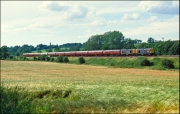 |
With few booked passenger workings, class 20s have always been popular traction for railtours. The "Stilton and Branston Ploughman" run on 5 July 1987 was no exception and I was especially pleased because it gave the chance to photograph a locomotive-hauled train on the normally DMU only North Warwickshire line. It was also the first time I had recorded 20s, 20022+20126, on this line. The spot selected was a rural view just south of Wood End tunnel. The train was late and with the sun going in and out the wait was a little fraught. However, when the special finally appeared the sun, although not at full strength, was not at all bad. This was an attractive location but I wish that I had gone to somewhere with a little more character and with something to identify that this was the North Warwickshire Line. |
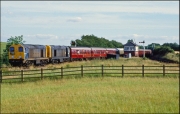 |
After visiting Stratford-upon-Avon the train returned north via Bearley Junction, where it is pictured below with some happy-looking bashers visible, on the single line to Claverdon and Hatton North Curve - more very rare line for loco haulage. This shot was not really worthwhile for some years before the signalbox was demolished because a lot of trackside infrastructure such as a communication mast and various relay boxes were built here when Bearley Junction 'box took over responsibility for signalling at Stratford-upon-Avon when the 'box there was removed. The lower quadrant signals just about visible in the right background, the smaller arm of which controlled access to the single track to Hatton. These signals were converted to examples operating in the upper quadrant some time after the date of this photograph. |
_110389.jpg) |
Over the years, the North Warwickshire Line has seen its share of rare and unusual workings, but to the best of my knowledge, only one High Speed Train (Intercity 125) has travelled the full length. This happened on Saturday 11 March 1989 when Red Nose Day was marked by the running of The Bakers Dozen by Hertfordshire Railtours from London St Pancras to London Liverpool Street via Stratford-upon-Avon, Birmingham, Norwich and Yarmouth. HSTs have used the branch from Bearley to Hatton on many occasions, including a daily scheduled service to and from Stratford to London Paddington in the summer of 1991. For those interested in the tour, the power cars were 4305 + 43092 complete with a Comic Relief nose on the grille of each. The train is here seen in shocking weather as it passed Bearley Junction signalbox while en-route from Stratford to Birmingham photographed from a rather soggy field. The more usual form of train to be seen here is represented by this four car DMU running about 20 minutes ahead of the HST. |
|
|
A rare overnight ballast train for the North Warwickshire Line appeared on RTT in early May 2023 with the service code showing that it would be operated by Freightliner. Although not unprecedented following 2021 appearances on RHTT trains, I had no daylight shots of FL locomotives on the line other than some light engines on route learners. The possession ending early on 16 May 2023 was the entire NWL with 6Y60 booked to leave it at Bearley Junction at 05.45, run to Stratford-upon-Avon and sit there for about 45 minutes. I suspected that it might leave Stratford early so as soon as it passed Bearley Junction I went to Danzey station which is an easily recognisable location. As predicted 66585 and 66520 with a short set of autoballasters did leave about 30 minutes early and although there were a lot of shadows at 06.23 the images were acceptable. I took a short video clip as it was such an unusual working. |
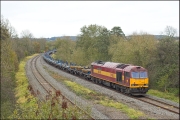 |
On Sunday 2 November 2008, the engineering work around Danzey on the North Warwickshire Line continued. I saw a message saying that at least 2 of the trains were at Henley-in-Arden and looked set to head south to Bearley Junction where they would reverse and return to Bescot via Hatton North Junction and Solihull. The nearest good photographic location for me is the aqueduct at Edstone and on arrival I found a long train of empty rail panel carriers in position. It wasn't exactly photographable because the centre of the train was plumb underneath the canal, with 60060 and 60045 on either end. It wasn't long before I heard a horn in the distance which I took to be the first of the trains moving away from Bearley Junction and shortly afterwards, the PICOP moved the stop board/light so that 60060 could move forward, wrong line, to the junctiion. Here is 60045 bringing up the rear of the train as it heads south. |
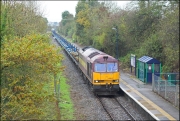 |
The obvious next move for another shot of the train, by then headed by 60045 after reversal at Bearley Junction, was Claverdon station. I think it is important wherever possible to have a clearly recognisable backdrop for pictures on lines where locomotives are a rarity and a station is the ideal spot. Here is 60045 passing through the platform at Claverdon with its train of empties - the first of the class I have photographed on the single line stretch betweeb Bearley and Hatton West Junction. 60060 is just about visible through the murk on the rear of the train, and here is the locomotive again passing the site of the original station at Claverdon. I don't much go in for "going away" shots, but wanted to take the rare opportunity to the show the view here with something other than a unit. The fenced-off structure has appeared since my last visit here and doesn't add to the rural ambience of the photograph... |
 |
A special train to mark the 100th anniversary of the North Warwickshire Line ran from Birmingham (Snow Hill) to Stratford-upon-Avon on Tuesday 1 July 2008 carrying various London Midland Trains dignitaries and assorted hangers-on. There was no mention of the type of train involved but my guess was that a reliveried class 170 would be rostered for it. I went to Edstone Aqueduct on the North Warwickshire Line to see the working and wasn't especially surprised when... a reliveried class 170 appeared! Despite the sky being largely clear a large patch of cloud managed to be in the wrong place as 170508 passed under the longest cast iron aqueduct in England. Although there have been occasional vists by class 170 to the line I believe that this is the first of an example in this colour scheme. A few minutes earlier, 31454 had gone in the same direction forming an 0Z31 Derby to Derby via Stratford-upon-Avon, presumably as a driver route knowledge refresher for SERCO trains. |
|
|
A charter from London Euston to Stratford-upon-Avon via Bedford and Coalville ran on Saturday 18 February 2017. I'm not overkeen on photographing most charters but this involved class 67s 67029 + 67022 and was routed over the North Warwickshire Line via Henley-in-Arden and was, as far as I know, the first working of the class over the line although several have reached Stratford from the Hatton direction. In the past I have usually headed for Henley station for charters but fancied a change so, bearing in mind that some of the stations on the line such as Danzey and Wootton Wawen are dull to say the least went for a shot as 1Z67 passed under Edstone aqueduct, near Bearley Junction. The light was abominable but I felt that it was well worth getting a record shot as the train, in top and tail mode slowed for the junction. The return to Euston via Hatton North Junction was scheduled for an after dark departure leaving Stratford at 17.36 and went unwitnessed by me at least. |
|
|
Colas Rail has recently acquired 2 class 67s for use on test trains and with a 1Q48, which includes the North Warwickshire Line and Stratford-upon-Avon in its itinerary, being scheduled for 22 March 2016, I wondered if they might be allocated. I saw that overnight they had moved from Toton to Derby RTC which shortened the odds and I soon had a message from a friend confirming that 67023 + 67027 were indeed on the train. I think that this was their first run other than some tests so was keen for a shot or two and, with the good weather, was planning on a trip to Henley-in-Arden. After the booked stop near Tyseley 1Q48 joined the North Warwickshire Line some 8 minutes early so I headed off only to be faced with dark skies and rain along with horrendous traffic leaving an industrial estate on the outskirts of Stratford. This forced a quick change of plan, a different route and me bolting to a closer location, Edstone Aqueduct, near Bearley Junction. This was really the last place I wanted to go because I had photographed the first 67 working on the line there just a few weeks ago. Whatever, I made it with a few minutes to spare and just before the really heavy rain arrived. I don't much go for going-away shots because they look all wrong to my eyes but here is 67027 bringing up the rear. I waited in the small car park at Edstone to see into which platform 1Q48 was routed at Stratford and as it went into No. 3 for its 2 hour layover I went home. The later visit was at midnight and went unseen, by me, at least. |
 |
After a very cold spell with heavy snow and leaden skies, the morning of 7 January 2010 turned out to be beautifully clear and sunny but with below-zero temperatures so that the snow wouldn't disappear too quickly. I was keen to get a shot or two in these perfect conditions but didn't want to run the risk of a bent car or worse just for a photograph of a train. With this in mind I went just a few miles from home to the aqueduct at Edstone, between Henley-in-Arden and Stratford-upon-Avon, arriving in time for the train from Stourbridge Junction due to pass there at about 12.10. Unsurprisingly, 150007 was a few minutes late when it came into view, running through the very attractive Warwickshire countryside. The surroundings fields were an absolute picture in the snow and here is the view towards the diminutive River Alne, which runs along the extreme left of the picture, passing the small hut just visible by the hedge. |
 |
During the recent snowy weather I was lucky enough to obtain a reasonably attractive picture of 150007 from the towing path at Edstone aqueduct betwen Henley-in-Arden and Stratford-upon-Avon. When the sun appeared on Saturday 30 January 2010 I decided that it would be a good idea to repeat the shot but with the "normal" landscape, so here is a very clean 150122, albeit with 2 coaches rather than 3, in the same spot. After taking this photograph I made the short drive north to Henley in order to finally get a sunny shot of the 13.05 arrival there; one which cloud has so far meant I have missed. On arrival, the sun was beautiful so I took this view of the switched out signal box and starter and inner home signals and newly laid track, not to mention the recently arrived white trackside container no doubt to accomodate something or other for the ongoing engineering work. By the time the passenger train was due some small patches of cloud had appeared: need I say more? |
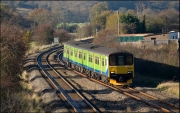 |
Monday 15 November 2010 was another of those beautiful days with clear winter sunshine. Whilst I quite wanted to take a couple of pictures I couldn't be bothered to travel far so just went a few miles from home to the aqueduct at Edstone, on the North Warwickshire Line with the aim of getting a shot of RHTT. Running in front of the MPV set was 150005 on a Stourbridge Junction to Stratford-upon-Avon train which is here seen having just passed a new signal put in place during the recent extensive engineering work on the line. |
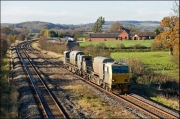 |
This picture of the North Warwickshire Line RHTT is taken from exactly the same spot on the towing path at Edstone Aqueduct as that of 150005 shown above but with a much wider angle lens. The two MPVs with 98908 leading are on the run down to Bearley Junction and then Stratford-upon-Avon on 15 November 2010. There are still some Autumnal colours around here although some very strong winds over the preceding weekend removed vast numbers of leaves from trees around here and thus marked an end to one of the most colourful seasons that I can remember. |
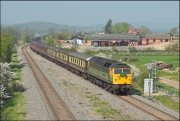 |
A locomotive-hauled train to my home town of Stratford-upon-Avon is always something to which I look forward and none more so than the Green Express charter from Holyhead on Saturday 14 April 2007. This was booked for class 47s 47851 and 47854 running in top and tail mode to ease the problems with shunting and, unusually, ran via the North Warwickshire line, a line not noted for seeing locomotives of any description. 1Z22 was running about 30 minutes late due to problems in the Penkridge area resulting in a diversion across the Cannock Chase line through Hednesford. 47851 is here seen about to pass under the Edstone Aquaduct near Bearley, the longest cast-iron aquaduct in England. The early morning haze has pretty well burned off, but with just a slight mist in the distance which, to my eyes, enhances the scene. The North warwickshire line has some attractive but completely anonymous locations and some complete with a signal box and semaphores that are of little use until the sun is further round later in the day. |
|
|
The excitement on the Birmingham to Stratford-upon-Avon line is never-ending! There should have a press sun for 7029 Clun Castle on 29 July 2021 but the locomotive has problems with its superheater and was not fit to run. Vintage Trains therefore provided extremely acceptable substitutes in the form of 20189 and 47773 which topped and tailed 1Z33 from Birmingham Moor Street to Stratford. It was mostly cloudy and I was tempted to visit Wilmcote station but thought that if the sun were to come out it would be a bit straight down the line. Edstone Aqueduct was therefore my choice of location and the 4 photographers, 2 of whom were expecting steam, stood chatting in full cloud cover. Just as 20189 came around the curve the sun popped out of the edge of a big bank of cloud which gave the scene a huge boost. Tailing the train was 47773 but the going-away shot isn't great so I didn't bother. I imagine that the the class 47 is required to lead out of Stratford because of the 1/75 of Wilmcote Bank which might make a single class 20 have a coughing fit! |
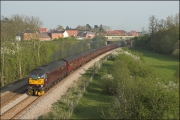 |
The return working of the Green Express charter from Stratford-upon-Avon was booked away from the terminus at 17.11 and I could think of no better location at this time of day than the Bishopton Bypass road bridge. This has the huge advantage of being no more than a couple of minutes away from my home! Here is 47854 with a good show of exhaust about to tackle the 1/75 climb of Wilmcote Bank. The houses in the background are relatively new, having been built for only about 12 months. For once, I think the that estate has improved the photograph here by giving some interest to the backdrop. |
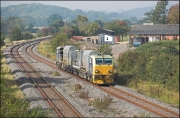 |
The beginning of October usually marks the start of the railhead treatment season when various trains run either to apply Sandite to the rails or to blast away leaf debris rolled into a slippery paste by other trains' wheels. Most lines have some form of treatment but only those using top-and-tailed locomotives ever seem to get any publicity. It may be unfashionable to say so, but I much prefer to have the chance to photograph a train formed of Multi-Purpose Vehicles (MPV) as they are more elusive than locomotives which, after all, can be photographed somewhere practically every day. Here is MPV DR 98957 running as 3S87, the 09.05 from Kings Norton, about to pass under the cast iron aquaduct at Edstone on the North Warwickshire Line, where some Autumnal colours are begining to show, some 30 minutes early at 13.00. As this stretch has a gentle downhill gradient no jetting is being done, but I heard the spraying start as the train approached the braking point for units going towards Bearley Junction and onwards to Stratford-upon-Avon. Click on this hyperlink for a closer view of the unit. |
 |
After photographing 3S87 at Edstone I went to Henley-in Arden for another crack at it, despite knowing that the sun would be straight into the lens. I needn't have worried as mist and cloud built up quite quickly after I arrived. The early running continued as the MPV sprayed through the station startling at least one passenger waiting for the 12.20 from Stratford-upon-Avon - he heard the train approach, got up from the seat and leapt back as this appeared! Henley station has some attractive features, click on this hyperlink for a look as the train continued north. |
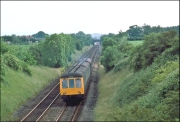 |
This photograph has almost nothing to commend it but it is my only one that shows the Henley-in-Arden up distant signal albeit from a long way away. Taken on 28 June 1987 it shows a three coach DMMU working from Stratford-upon-Avon to Birmingham Moor Street which has just passed the signal in question. It is slightly unfortunate that the signalmen was on the ball this morning and has immediately returned the power assisted arm to on the "on" position as it would have been much more visible if it has stayed "off" for a few seconds longer. I had intended to return to this bridge along with that in the background to obtain a couple more shots with the signal but forgot. Too late now... |
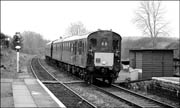 |
I imagine that this is the only occasion on which a Hastings DEMU has run along the North Warwickshire Line through Henley-in-Arden. The train is here seen passing the now removed upper quadrant signal on 8 March 1997 as 1001 heads toward Birmingham Snow Hill after visiting Stratford-upon-Avon. These units were originally designed to run with six coaches but if my memory serves me correctly, only four were preserved and a fifth "out of gauge" was later added to increase capacity for these popular tours. A sixth, from a CEP EMU, is now available. The wider body of the centre coach is clearly visible in the view thanks to the curvature of the line. |
 |
In the 1980s, just as today, charter trains occasionally visit Stratford-upon-Avon. This one, headed by 47534, ran on Saturday 23 June 1987 and is here seen passing the station at Henley-in Arden. It wasn't long after this that the GWR building on the island platform was demolished although the roof canopy had already gone, along with the hut covering part of the car park. My notes say that this was a PARSPEC, an unadvertised party special or private charter, from Carlisle. The weather was very dull and I do not have a photograph of the return working despite it running close to the longest day so must assume that the light didn't improve over the course of the day. |
|
|
Following the press run with 20189 ruuning solo from Birmingham Moor Street to Stratford-upon-Avon on 29 July 2021 Vintage Trains added 20227 for the Shakespeare Express on the following Sunday, 1st August. The first train ran as 1T50 and with the weather being dull with no immediate chance of sunshine I took the short walk to Stratford-upon-Avon Parkway Station. Here are the pair with 8 chocolate and cream coaches coasting through the station on the way to the Stratford's GWR terminus. |
|
|
The second GBRf operated ballast over the North Warwickshire Line worked overnight on 9 & 10 April 2024. This time the train, 6G61, ran from Bescot to the possession which commenced at Tyseley. The part in which I was interested was in the morning when it was scheduled to leave Bearley Junction at 05.40, run to Stratford-upon-Avon for reversal and head back to Bescot via Henley-in-Arden. It ran close to right time because of two ECS trains to Stratford in the area so I didn't need to leave home until it was past Wilmcote on the down run. I wanted a shot at Henley-in-Arden and 6G61 was timed to be there at just about sunrise. Despite this I had to use ISO 4000 because it seemed likely that the train wouldn't be hanging around and this was the case with a filthy 66748, 5 autoballasters and a much cleaner 66798 on the back. AS this was the first time I seen GBRf locomotives north of Bearley Junction I took this piece of video. Henley station has recently been beautifully refurbished with a micro-brewery, community room and bar being part of it. |
|
|
I wanted a completely recognisable location for the afternoon Shakespeare Express, 1T53, so went to Henley in Arden station where a lucky patch of sunshine arrived just at the right time although not shining on the full set of coaches. It was running 3 minutes early here and had a 2 minute pause scheduled so it was quite a while before it moved away towards Bearley Junction and Stratford making some excellent sound effects. |
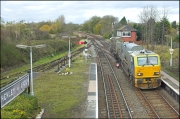 |
The DMU booked in front of this RHTT cleared the signalling section which currently ends at Bearley Junction and this allowed the signaller to pull off the signals giving 3S87, the Kings Norton to Kings Norton via Stratford-upon-Avon RHTT, a clear road. A couple of minutes after the inner home signal was raised, the sun came out and I took this picture of the bay platform and siding signals. I did once ask a signaller here if it might be possible to take pictures with these signals in the "off" position, but he declined, saying that he thought it quite possible that the points, if moved across to allow the signals to be pulled off, might well not go back again! Anyway, 3S87 with DR98958 leading, came right on time and shortly after the sun went in again, this time into a sky full of black cloud. |
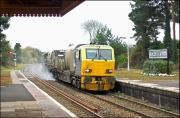 |
I hadn't really intended to stay at Henley in Arden for the return of 3S87 but changed my mind so as to get this picture as it ran through the platform with its water jets going at full belt. A cloudy sky was helpful on this occasion so that a shot looking towards the south-west was possible. Unlike the last time I saw this working, it had been held to right time either at Stratford station or Bearley Junction which meant that it should have crossed a Stratford-bound class 150 in the platform. Fortunately, the DMU was a minute or so late and my shot, with DR98908 now leading, wasn't obscured. |
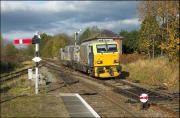 |
I always like to take a few pictures of the RHTTs on my local lines and once the clocks have changed at the end of October there are few better places for a shot than Henley-in Arden. Here is DR98912 leading 3S87, the Kings Norton to Kings Norton via Stratford-upon-Avon train, past the signalbox and associated semaphore signals. To be quite honest, as one who was brought in GWR territory, I should prefer signals operating in the lower quadrant but the pegs here still are an attractive feature of the North Warwickshire Line. It won't be long, probably less than 12 months, before the box here is taken out of service and the signals replaced with modern equipment operated from Landor Street panel so this year may well be the last chance for this shot. For a better view of the signalbox, use this hyperlink. One benefit of the resignalling will be that a half-hourly passenger service will be possible throughout the day with the chance to run trains with fewer stops, thus resulting in much reduced journey times. There will also be more paths available so the few special trains that run from the north to Stratford may be routed this way. |
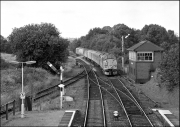 |
This black & white photograph from 22 July 1998 shows 37114 + 37431 topping and tailing the weedkilling train through Henley-in-Arden. I think that this was the final year in which the line saw locomotive hauled spray trains, MPVs being used thereafter. This working was booked to run to Stratford-upon-Avon for reveral and then to head for Birmingham via Hatton West Junction, Hatton Station for reversal and then across the spur at Hatton between the branch platform and the down main line. I charged over to Hatton after taking this shot and arrived in plenty of time to hear the reversal take place out of sight as the train ran from Hatton West to North Junctions. There wasn't, of course, time for the walk from the road bridge adjacent to Hatton station to the field at North Junction! |
 |
A colour picture taken from the same spot as the shot above but dated 2 May 1994 shows a real hotch-potch six car DMMU about to make the Henley stop. This Bank Holiday Monday saw first generation DMUs replacing the usual class 150 sprinters presumably to cater for the influx of visitors to Stratford from the West Midlands conurbation. The police were always out in force on these holidays to keep an eye on any would-be tourists who had drunk more than was good for them (and anyone within earshot) on the journey in. These characters were usually dumped unceremoniously in a van and taken away to sober up before being put back on a later train without being allowed into the town. |
_SBJ_Hen_281009.jpg) |
The regular passenger services along the North Warwickshire Line run between Stourbridge Junction and Stratford-upon-Avon. These are currently formed of class 150 DMUs although new class 172 units should make an appearance in the relatively near future. Here, 150007 forming the 14.27 from Stratford, calls at Henley-in-Arden and is using platform 2 from which the overall canopy was removed many years ago, the passenger accomodation now being a steel and glass shelter. The canopy remains on platform 1, but somewhat bizarrely, there are no seats of any description. New signage was being fitted during my visit and it is to be hoped that a use may be found for the boarded up but still sound building. In common with several other stations along the line, Henley has been painted in some rather odd colours, bearing no relationship to any railway company colour schemes either past or present. Before many minutes had passed, 3S87 returned north and is here seen between the up and down signals on the Stratford side of the station. The RHTT has to wait here for a few minutes until the preceding passenger train had cleared the section by reaching Shirley station. |
 |
The inspection saloon named Amanda ran from Derby to Stratford-upon-Avon and then on to Shrewsbury and Birkenhead on 18 July 2007. The outward run to Stratford was via the North Warwickshire Line amd with such a short train I felt that a compact and not too open a location was needed as it would look a bit silly on a wide stretch of main line. Even though I knew that the light would be either straight or on the "wrong" side at Henley-in-Arden I felt that the infrastructure at the station would make up for the less than ideal lighting. The saloon was headed by WCRC's 47854 and the train, 2Z01, was booked to stand at Tyseley between 12.17 and 12.40 to follow the local train to Stratford. Given the line occupation here, I thought it far more likely that it would precede the passenger and arrived at Henley-in Arden at 12.30. 47854 passed me at 12.45, exactly 30 minutes early on the booked schedule. |
 |
A loco-hauled charter train from Stratford-upon-Avon to Llandudno was run on Saturday 2 July 1992. I went down to the station first thing in the morning to see the ECS arrive and was pleasantly surprised to that 47258 had been allocated along with a rake of Regional Railways liveried stock. Here is the class 47 running round the stock just after arrival in some transitory sunshine. This scene has changed almost beyond recognition in the intervening years with the demolition of the rail-served Ministry of Food cold store and its replacement with the inevitable supermarket. It was widely believed by some of the more gullible inhabitants of Stratford that the wartime food store also contained a nuclear bunker intended for use as a regional seat of government should the Eastern Bloc countries deploy their nuclear arsenal against us - proved to be a complete fallacy when the facility was demolished! |
 |
As I said above, the early morning sun didn't last long on the morning of 2 July 1992. A Stratford-upon-Avon to Llandudno charter ran on that day and utilised 47258 along with a set of Regional Railways stock. Unusually, the train was routed via the North Warwickshire line and is here seen having just passed Henley in Arden. The signal box at the station was switched out on Saturdays at this time, and in the absence of an intermediate block point this meant that there was a long section from Bearley Junction to Shirley; the fringe signalbox for Saltley panel. 47258 was the locomotive used on the last coal train to Chinnor cement works and some shots of this appear in my Buckinghamshire and Oxfordshire pages. |
|
|
The regular test train from Derby to Tyseley via Stratford-upon-Avon ran on nTuesday 22 May 2019. This was the first time since the previous Autumn that 1Q48 would be photographable on the North Warwickshire in daylight; its passing time for Henley-in-Arden being 18.39. It seemed likely that that the sun would be shining after a partly cloudy afternoon so I drove to Henley station where the only stretch of line largely clear of shadows was off the northern end of the platforms. The train was running a few minutes late because the preceding passenger working was late due to a passenger having been taken ill earlier in the day. This set up the very real possibility that another unit from Stratford upon Avon to Worcester might be in just the wrong place but it came and went with a good 30 seconds to spare. Here is 37521 topping and tailing the stock with 37610, substituting for the usual 67023 + 67027, approaching the station at low speed under a signal that had just been cleared from red to green. This accounts for the exhaust haze from the locomotives as the driver opened up. |
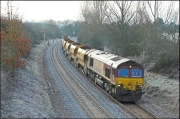 |
I had taken quite a few pictures at Henley-in-Arden station in recent months so decided to go to another location a little further north for a shot of 66081 with 6P01 to Bescot. It was a freezing morning with the very weak sun much too low to get into the cutting but I still quite fancied the shot as it includes both the upper and lower quadrant signals that will disappear later this year when the line is resignalled. I heard the train coming for some time on the still morning but even with plenty of time to get everything set up I, for the first time since beginning to use digital equipment in 2004, didn't switch on the camera as 66081 came into view. This meant that not only was the light in the cutting virtually non-existent but I had to reset the zoom length and take a hurried grab shot, the results of which are all too plain to see! I hope that another opportunity to get this shot comes along soon so that there is a chance to get a sharp version! My thanks to David Weake for the information on 6P01. |
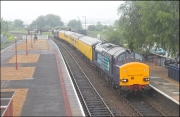 |
Test trains are relatively infrequent along the North Warwickshire Line between Tyseley and Stratford-upon-Avon compared with some more major lines, as indeed are locomotive hauled trains of any description and are thus worth going out for. On Friday 25 June 2009, DRS class 37s 37218 and 37607 topped and tailed a 1Q13 from Tyseley to Derby via Stratford, Birmingham Snow Hill, Blakedown, Stourbridge Junction, Round Oak and back again to Hatton North and West Junctions and thence on via Washwood Heath to Derby. The weather was vile during the first part morning with mist and drizzly rain being the main features until the real rain set in later. Here is 1Q13 arriving at Stratford-upon-Avon spot on time, with 37218 leading, in dreadful light. It's lucky that the train was stopping here so that a shutter speed of 1/250 was enough to freeze the action. For a look at the scene here in 1990, click on this hyperlink for a picture, albeit in slightly better lighting conditions, from 28 March of that year. This is an afternoon photograph and if the sun is out in the morning there isn't much of a shot available, so maybe the poor weather for 1Q13 was an advantage. |
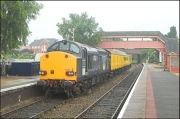 |
1Q13 with 37607 and 37218 was booked to stand at Stratford-upon-Avon for the thick end of 30 minutes so after taking this shot of the train standing in a misty platform 1 at Stratford-upon-Avon I asked the driver if he thought that they might get away a bit early or have to wait for a right time departure. He told me that it would be as booked so I decided to make the 10 minute walk home to pick up my car and head off to Henley-in Arden on the North Warwickshire Line. |
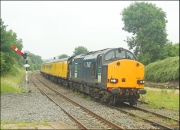 |
After the walk home from Stratford-upon-Avon station and a very slow drive to Henley-in-Arden behind an ancient (and empty) school bus seemingly incapable of more than 30mph I arrived at the station to find the signal for the down line "off" for a DMU to Stratford and "on" for the line to Birmingham. The DMU arrived within a couple of minutes and the driver and senior conductor asked me what was expected as they had seen several photographers further along the line. I am indebted to the driver of the Stratford-bound train for this photograph, as he pulled away from the station stop very slowly indeed so as not to block my view of 37607 leading 1Q13 into the platform, the signal having been cleared as the train approached it. In fact, the DMU was right by my shoulder as I pressed the shutter release! I like to take these rarities in totally recognisable locations and here is the view of Henley-in-Arden station as 1Q13 passed through. I'm not sure what has happened to the light on platform 2; it looks as if one side has been removed, possibly to save a little power... |
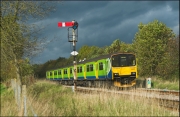 |
The weekend commencing 24 October 2010 saw the closure of the North Warwickshire Line for the thick end of one week while the semaphore signalling was removed and some track remodelling took place. I have long had a fondness for the line and its infrastructure despite, or perhaps because of, the fact that no locomotive hauled trains are scheduled to run along it. The sole remaining lower quadrant signal between Bearley Junction and Tyseley was to be found just to the north of Henley-in-Arden station and here is a picture of 150011 passing it on Friday 21 October as it slows for the Henley stop with an afternoon train from Stourbridge Junction to Stratford-upon-Avon. The shot I actually wanted would have been taken just before the unit passed the upper quadrant signal visible over the middle coach but the undergrowth was just too obtrusive; much worse than that visible over the front of the class 150. Conventional stepladders wouldn't have been much help as the ground on this public footpath was too soft and uneven for them to be safely used. |
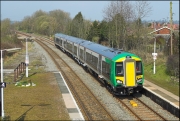 |
The class 172 mileage accumulation runs continued on 16 and 17 March 2011 with 172332 working with GBRf crews between Tyseley and Stratford-upon-Avon. The sky began to clear at lunchtime on 17 March so I thought that a sunny shot of the new unit might be possible, unlike the one that I had taken earlier in the day at Edstone, just north of Bearley Junction when the preceding class 150 was in perfect light but the 172 managed to come in a thick bank of low cloud blowing in from the west. My afternoon shot was at Henley-in-Arden where the sun was perhaps a little too straight at that time but just about about acceptable, especially when compared with my earlier efforts. |
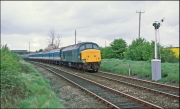 |
Class 45 locomotives were at one time seen quite often on the North Warwickshire Line while hauling freight trains to and from the South-West and South Wales. Once the line had closed south of Stratford-upon-Avon they became rarer and were restricted to occasional engineers trains and charters. One of the latter 45052, is here seen on 2 May 1988 with the Avon Lady tour from London St Pancras to London Marylebone via Leicester, Nuneaton flyover, Birmingham, Henley-in-Arden, Stratford-upon-Avon (reverse), Hatton, Solihull, Birmingham New Street, Stafford, Rugby, Northampton, Milton Keynes Central, Denbigh Hall South Jn, (via Bletchley flyover), Claydon L&NE Junction, Aylesbury, High Wycombe, Amersham, Harrow-on-the-Hill, and Neasden South Junction. As it was a Bank Holiday Monday, the light was very poor and I could use a shutter speed of just 1/125 second on 100asa slide film. This is the reason for taking the shot by Henley's down outer home signal so early, so as to avoid too much speed blur as 45052 hauled 1Z37 past me at the line speed, 60mph. |
 |
This is the view looking towards Henley-in-Arden using the lower quadrant advance starter as a photographic prop on 22 October 2010. The train is the Rail Head Treatment MPV set used to blast leaf debris from the line and apply a layer of sandite material to give enhanced grip. It is fortunate that the ash tree just inside the fence had lost most of its leaves during the preceding few days of the shot would have had even more vegetation obscuring DR98959 than was already the case. It's a shame that the signal's finial had been removed as semaphores with them just don't look right but sadly, there were very few left along this stretch of line. The RHTT had been standing in the station for around 15 minutes waiting for a path back along the section of line to Shirley, the next block section, as 150005 forming the 14.27 Stratford-upon-Avon to Stourbridge Junction was occupying the line. The MPV had previously run to Stratford-upon-Avon with DR98909 leading. |
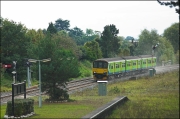 |
This picture shows 150011 approaching the stop at Henley-in-Arden station on 22 October 2010 with the 15.27 from Stratford-upon-Avon. It is passing the two semaphore signals at this end of the station and is kicking up quite a cloud of sandite material; being the first train to run over the up line since the RHTT shown above had passed. The replacement LED signal on its heavily engineered gantry is also in view; functional no doubt, but not quite as photogenic. The light picked up a little as 150011 pulled away from the station and ran past the two signals at the north end of the platforms. |
 |
If anyone actually looks at my DMU pictures then they won't be surprised to see yet another version of this shot at Henley-in-Arden. My excuse this time is that this is last photograph with active semaphores and signalbox that I took as the 'box was due to be closed and signals taken down within a few hours of this being taken on 22 October 2010. The advantage of the new signalling régime will much be the potential for more frequent services between Stratford-ipon-Avon and Birmingham although it is unclear at the time of writing if anything of this sort is even in the planning stages of being planned... Here is the same unit, 150049 passing the much less frequently starting signal at the south end of the station. |
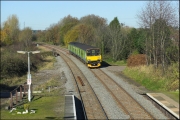 |
Following the radical changes of recent days to the scene around Henley-in-Arden I thought that I may as well wait for a day with some decent light before going back once to obtain a picture of the area just north of the station where the signalbox and associated semaphores used to be. Wednesday 10 October 2010 was such a day so I planned to go and have a shot of the 13.05 arrival from Stourbridge Junction. Here then is 150019 about to pass the patch of bare earth occupied by a the signalbox for over 100 years and no doubt even this patch will soon be indistinguishable from the rest of the surrounding vegetation. |
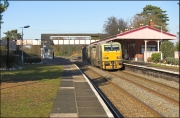 |
A Rail Head Treatment Train is booked to follow the DMU in the picture above down the North Warwickshire Line. Sure enough, about 25 minutes later I heard the hissing and rattling as DR98909 led the MPV formation towards Henley-in-Arden. Shadows from the trees on the left of the station had begun to encroach on the tracks through the platform but the main part of the scene was in the beautiful sun that had followed a cloudy start on 11 November 2010. The station hasn't really changed a huge amount in the last 20 odd years and for a look at how it was in 1987 use this hyperlink to see a photograph of 47534 taken in approximately the same spot on the platform. |
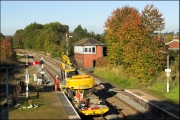 |
During the afternoon of 25 October 2010 I had a quick trip around the Wilmcote, Edstone, Wootton Wawen and Henley-in-Arden area to see if I could find any of the engineering trains on the North Warwickshire Line. All that was visible from public vantage points was the back of a ballast train just to the south of Edstone Aqueduct so after not photographing that I went to Henley and found this road-rail vehicle loading some redundant material from the lineside adjacent to the signalbox. The inside of the 'box was being stripped of anything either reusable or valuable before demolition. A large lorry with a skip and hydraulic crane was in the car park at the south end of the station and here is a picture after the road-rail vehicle has unloaded its scrap, including the upper quadrant down outer home signal which was situated a few hundred yards to the north of the signalbox. Note that the new LED signal operated by from Landor Street is illuminated. |
_Henley_01.jpg) |
Continuing my photographic efforts along the North Warwickshire Line, the afternoon of 1 September 2010 saw me at Henley-in Arden. The shot that I had had in mind wasn't available because of a lot of tall grass and will need some substantial steps to achieve. I had left myself enough time to get back to the station footbridge in case something was wrong further along the line and I arrived back with a few minutes to spare before 150011 passed the signalbox and upper quadrant semaphores on its way to Stratford-upon-Avon from Stourbridge Junction. The signals and 'box, of course, are due for demolition within a few weeks and although I have plenty of shots taken from this exact spot, I felt that another in perfect late summer light wouldn't go amiss. Many people will disagree, but I feel that a scene like this on a country railway has far more to commend it than yet another picture of a class 60 on an oil train or a class 66 on an intermodal on an anonymous piece of main line, especially when the scene is about to change for the worse. |
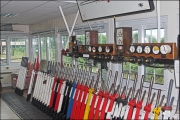 |
Over the years I have had a couple of visits to the signalbox at Henley-in-Arden and this picture shows part of the frame and the suspended instrument shelf looking towards Stratford-upon-Avon; the down side. The white levers once operated a crossover between the main lines along with the associated locks and ground signals. There was no up loop here, any train required to use the bay platform would have had to have drawn forward beyond the points opposite the signalbox at the other end of the station and then propelled into the siding. There was, however, a connection between the platform line and the other line at either end so that a locomotive could, if necessary, run-round its train. At the date of this photograph none of the recent changes to the track layout had taken place and the lines on the far side of the island platform and their associated signals were still in place and, nominally at least, operational. I say "norminally", because I asked the signaller if he would pull the necessary levers to put one and then the other of the signals controlling the exit to those lines in the "off" position. He had to decline, even though there were no trains due in either direction for at least forty minutes, because he feared that even if the points went across to allow the signals to be moved, then they quite possibly would not have gone back, leaving him with a bit of a problem! |
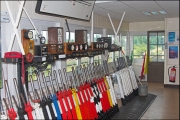 |
This is the other end of Henley-in-Arden signalbox, i.e. looking towards Birmingham. The large number of white levers are testament to the much larger number of points and signals that used to be here and which controlled the entrance and exit to the goods yard. This was on the site of the original station here which was to the right of the current down main line and on a curve. There once was a line here that joined up with the GWR Leamington Spa to Birmingham Line near Lapworth. This website is not the place for a detailed historical survey of the area, but many photographs and information will be found here, on the marvellous Warwickshire Railways site. I cannot recommend this site highly enough for anyone wanting to see pictures of Henley and Bearley when all the lines were busy and the signalboxes controlled many more signals and points than they did in their latter years. |
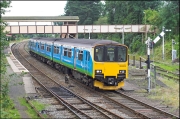 |
This picture demonstrates the proximity of Henley-in-Arden signalbox to the station. The train, 150003, is a departure from Stratford-upon-Avon heading for Stourbridge Junction. It had been quite a while since anything had used the rusted lines on the far side of the island platform but back in 1986 the platform side was used every weekday by the 08.13 train which commenced here and went to Birmingham Moor Street. I have always regretted that I wasn't carrying a wider angle lens that morning so that I could have included both signals in the scene. |
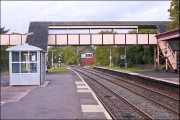 |
Here is a general view of the north end of Henley-in-Arden station taken a few days before the semaphore signal the controlling 'box were removed. I have long felt that it's a shame that more authentic GWR-style colour scheme of chocolate and cream haven't been used on the North Warwickshire Line rather than the grubby pinkish shade favoured by London Midland. |
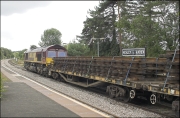 |
The North Warwickshire line through Henley-in Arden sees little in the way of locomotive-hauled workings, so when I heard that major track replacement was taking place on Sunday 8 October I went over to have a look. I had been told that a 7P12 from Bescot was on the way south at about 13.00 so when I arrived at Henley at about 13.20 I expected to find an empty station with the prospect of photographing a class 66 hauled ballast passing through. Instead of this, I found 66159 standing in the up platform with a huge train of recovered track panels together with a road-rail vehicle on the down line from which the crew were sawing off some excess lengths of track. There was little other than this photograph to be obtained so I decided to have a walk along a public footpath running north from the station to see if a photograph of the front of this train, 6P11, was possible. |
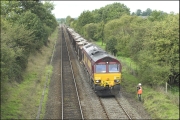 |
As it happened, the leading locomotive of 6P11 was not in a good position so I walked further along the path to the next overbridge. Here, 66186 was standing in just the right place for a photograph with 7P12, the driver being given instructions by the PIC of Operations. It was a piece of luck that the stop boards protecting the possession had been placed some 15 yards from the bridge; they all too easily may have been put somewhere less convenient. |
_6p10_henley_081006.jpg) |
7P12 soon obtained permission to proceed and is here seen moving away towards the station. It stopped at the outer home signal which gave me the chance to walk back to the station for another crack at it, but not before this taking this image of the brake van number 993914 at the back of the train. This is a Shark brakevan and would have been used to spread the ballast dropped from the Seacows. It may have also been included in the consist because local regulations state that any train left without a locomotive i.e. for run-round purposes, must have a brake in the consist because of the falling gradient from Henley-in Arden to Bearley. Thanks for Dave Ashworth for this information. |
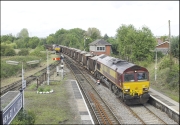 |
I had plenty of time to reach the station before the down line was cleared and 66186 allowed to proceed into Henley-in-Arden station. The train was under manual control and no signals were pulled off as the train passed the signal box and moved towards the possession. There is quite a contrast between this shot and the last I took here on 19 August when the Blue Pullman ran this way to Stratford -upon-Avon. By now, 6P11 with 66159 on the rear and 66185 on the front has pulled clear of the station, and I expected to see this train disappear towards Birmingham. In the event, something far more unusual was to happen... |
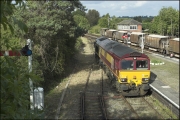 |
I was more than mildly surprised to see 66159 detached from the train and to see the points switched over to allow it to enter platform 3, or "the bay" as it is locally known. This piece of line is used just once each week day when an early morning train to Birmingham starts its journey here. I have never seen a locomotive make this move before and it gave me some degree of satisfaction to record it in the only sunny spell of the afternoon. Here is another view as the locomotive joined the track into the bay. |
_henley_0810.jpg) |
The driver of 66159 pulled his locomotive sufficiently clear of the footbridge to enable me to obtain this shot of it it the bay with 66186 waiting to head south with its train of seacows. It probably won't mean much to non-locals, but this sight is pretty well unprecedented and is one of those are events that make the session really notable. |
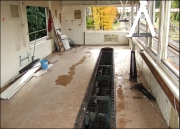 |
The end finally comes for Henley-in-Arden signalbox. This, showing a couple of abandoned signal wire tensioners, and the two linked photographs were taken just before demolition. This one shows for the last time the view towards the station including, ironically, the new LED signal at the down end of platform one controlled from Landor Street panel. The second hyperlink shows a wider general view including the remains of the interlocking frame. |
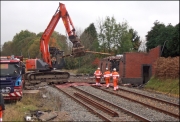 |
... and that was it. |
_DanzeyGreen_011108.jpg) |
Some major track renewal was planned for the North Warwickshire Line over the weekend of 1st and 2nd November 2008. Through the good offices of some friends and contacts it was established that the area around Danzey station was the worksite so even though the weather was dull in the extreme, I went across for a look. The major surprise was to find 60060 standing with one wagon in a completely photographable location; just about the only clear spot for miles and one with a little interest in the form of a road junction and field gate. The quality of the pictures was never going to be great given the appalling light, but locomotives are rare on this line so record shots just had to be taken. One has to be careful with the post processing of images where the subject is against a dark sky in order to avoid the heinous crime of a white sharpening halo around the locomotive roof; a sure sign that the whole photograph has been over-sharpened. Use this hyperlink for another view of 60060. |
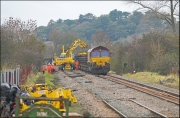 |
After photographing 60060 just south of Danzey station on 1 November 2008 I carried on to the station to find 66019 standing beyond the platform on a long train of flats loaded with the redundant track panels. The light was becoming worse by the minute and a strong wind was blowing but a couple of shots just had to be taken with the 200mm lens in conjunction with a monopod to minimise camera movement. Here is the train and a road/rail crane in operation along with all the uusual impedimenta of engineering work on the trackside. |
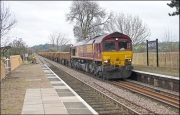 |
66019 soon pulled its train of track panels forward and out of sight to the south of Danzey station which allowed 66200 with a rake of empty JNAs to come into the area ready to be loaded with spent ballast yet to be dug out of the trackbed. This was the time for crew changes and a taxi came to pick up one set of men whilst a van carrying their relief arrived. By now it was nearly 3pm and the light had all but gone, so off home into the warm... |
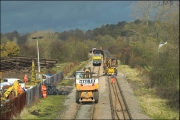 |
A second weekend of engineering work took place on the North Warwickshire Line starting overnight on 7/8 November 2008. I didn't know where the work was taking place so had a look at Henley-in-Arden where nothing other than line protection boards were visible, before driving on to Danzey Green. This was the scene there, with 60060 standing on the northbound line with a single track panel flat, 66177 at the head of a long train of scrap panels and and road/rail vehicle heading south and into the worksite. The track panels were in the process of being secured to the wagons but it seemed to me that the departure might not be too far away. I quite like watching the movements associated with permanent way work as it passes the time whilst waiting for a locomotive hauled movement. Here is another view at Danzey, this time of some more road/rail vehicles passing through the station, and here is a close-up view of the second of them. |
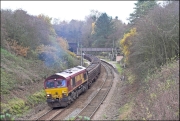 |
A friend turned up at Danzey and we decided that it would be worth the short trip to Wood End, the next station towards Birmingham, in case the train of scrap track panels standing wrong road made a move. Nothing happened in the 30 minutes or so we were there and as Steve had to return home he dropped me off at Danzey where my car was parked. After about 10 minutes, the driver of 66177 walked up the track and joined his train. This was the cue for me to go back to the road bridge just north of Wood End station and before too long I heard a horn as the 66 moved away form Danzey. A couple of minutes later the horn was blown again as it entered the tunnel and then the train stopped at the protection boards in the station. The appropriate board was soon removed and 66177 headed wrong line towards Shirley, the site of the first available crossover, and then off to Bescot. The light was quite poor but class 66s aren't all that common on the North Warwickshire Line and I was more than happy with the result as the train pulled away. As Danzey station was on the way home, I dropped in again to see if anything was moving. 60060 was still standing on the up line and it looked as if it was time for the relief crews to take over the job as several cars and vans appeared. I took a final shot of the yard, mostly because of the Autumnal colours and dark sky, before going home. |
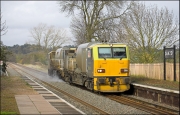 |
The weather forecast for the afternoon of 12 November 2009 indicate that strong winds and heavy rain would replace the clear skies of the morning. Hoping to catch to catch a cloudy but bright interlude I headed off to Wootton Wawen station, on the North Warwickshire Line, with the intention of taking a photograph of 3S87, the RHTT scheduled along there. When I arrived at the bridge over the station, the sun was out and, being in a cutting, the line was shadowed with a brightly lit background. This wasn't at all what I wanted, so had a quick drive to Danzey, on the other side of Henley-in-Arden where the sun, if out, would be in the right place. Naturally, as soon as I arrived, a thick bank of cloud appeared but as the train appeared in the distance a small hole in the cloud allowed the sun to poke through. New London Midland station signs have recently been erected here, replacing the previous Regional Railways versions. I really enjoy these short sessions on my local lines and much prefer it to spending a few hours alongside a main line somewhere photographing routine traffic, especially in poor light. Maybe, after many years, I have become more selective! |
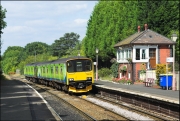 |
The North Warwickshire Line, from Tyseley to Stratford-upon-Avon, is in the throes of radical change. The remaining areas of semaphore signalling at Shirley, Henley-in-Arden and Bearley Junction are soon to be removed and the associated signal boxes demolished. The final dates for the 'boxes have now been set and I decided that it was time I went to Shirley to record a few scenes before all is changed. Bearing in mind the disappointing summer we have endured and that there's no point in going for an early afternoon shot much before the middle of August as the sun is too high, it was the last day of that month before I had about 90 minutes of decent light at the right time. Here is 150108 slowing to stop at Shirley station where the train will terminate before crossing over to the up line and returning to Kidderminster. The signalbox has been beautifully decorated by the resident signaller with a variety of plants, including this sunflower, for its final summer. |
_Shirley_310810.jpg) |
I have always thought that there is a lot more to railways than simply photographing locomotive-hauled trains on the main line as there is rarely much infrastructure of any interest on such lines and those who ignore the byways with some historical artefacts miss out. This is the 1907-built GWR signalbox at Shirley on 31 August 2010, just a matter of weeks before its demolition is scheduled. I understand that there was, until recently, some hope that if may have been preserved and used as office accomodation by London Midland but the plans have fallen through and a fairly rare surviving of a platform located 'box will be lost. Just to the Birmingham side of this scene is a short siding, these days used only very occasionally in the event of a unit failure but in busier days was used in the peak hours to stable a unit. Even further back in time there was a goods yard and shed in what is now the builders' merchant immediately behind the 'box. Here is an earlier shot of 150014 taken from the steps of the signalbox on a very wet day. |
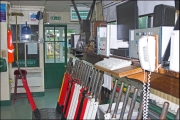 |
Moving inside the signalbox at Shirley, this is part of the frame and instrument shelf looking towards Stratford-upon-Avon as a blue class 150 DMU heads away on the up line. There is the familiar blend of traditional signalling equipment and the new, including TOPS and TRUST machines and modern emergency equipment. There is also a manual entitled "Water Risk Assessment", the usage of which isn't immediately apparent to me. Perhaps in this Health & Safety obssessed world it is do with the water cooler installed to provide a supply of drinking water for the signaller... |
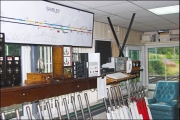 |
This is the view inside Shirley signalbox looking towards Birmingham showing the illuminated track diagram and the traditonal signallers' armchair. To the right of the window used to be the goods yard and although teh yard is long gone, the point and signal levers controlling access to the little-used siding still recall those days. Some of the dials connected with the up line signals situated on the down side of the 'box can be seen here. |
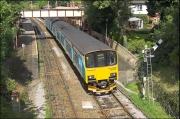 |
There is a twenty minute frequency passenger service to Shirley, where the trains currently terminate before leaving the station under the control of the upper quadrant starting signal and using the crossover to regain the up line before returning to Birmingham. The light was a little too straight for the picture of 150010 and in completely the wrong place for the linked picture of it about to crossover but I do, at least, have a record of the signals. Once the resignalling has been completed the trains currently terminating at Shirley on to the next station, Whitlocks End, where a new crossover will be installed. Quite why this extra movement was deemed necessary is unclear; I would have thought that a simpler option could have been developed which didn't need a seemingly wasteful move. |
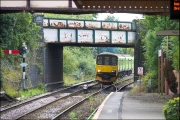 |
The crossover mentioned in the caption to the picture shown above is being used here by 150011 as it regains the up line at Shirley before it froms the 14.22 to Worcester Foregate Street on 31 August 2010. A lot of the ironwork in the picture looks as if it is ready for a good rub-down and new coat of paint. I wonder if this will happen when the forthcoming major possession is underway? Both the starting signal and ground dummy on the left of the train will be removed and the former's replacement is just visible by the DMU's roof. The ground signal will not be replaced as the crossover will be resited to Whitlocks End, the next station to the south. Just before leaving Shirley I took this picture of 150108 leaving for Kidderminster, largely so that I had a record of the outer starting signal with a train passing by. The longest lens that I had with with me was a 150mm example which wasn't, unfortunately, quite long enough for the job. |
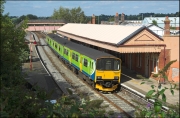 |
I had gone by train to Shirley for the pictures in the sequence above because there is rarely anywhere to park a car in the nearby area and travelled back to Stratford -upon-Avon on 150015. This is here seen amidst the faded Buddleia (Scrophulariaceae, a member of the figwort family) spikes from the Alcester road overbridge about to depart as the 15.27 to Stourbridge Junction. A chunk of plaster render has recently fallen off the station wall adjacent to the car rental company's office. How long will that stay unrepaired? |